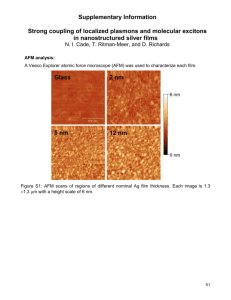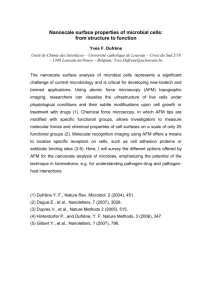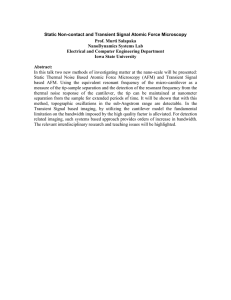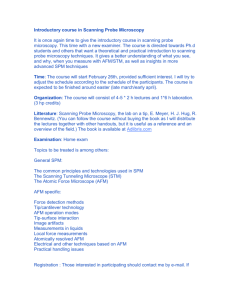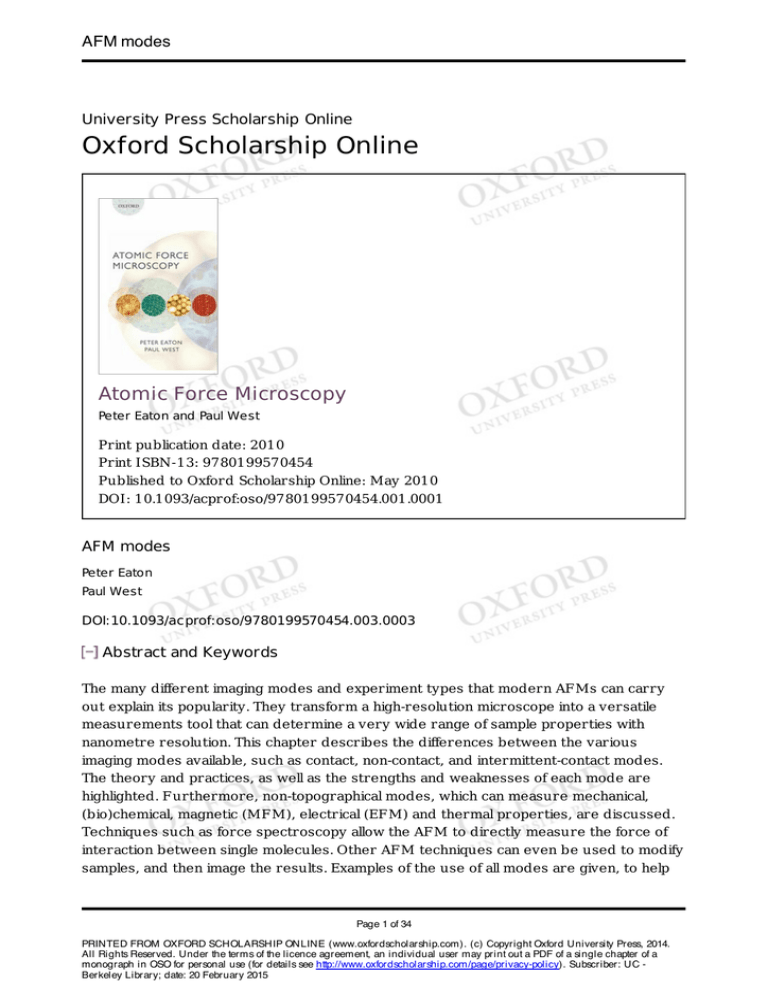
AFM modes
UniversityPressScholarshipOnline
OxfordScholarshipOnline
AtomicForceMicroscopy
PeterEatonandPaulWest
Printpublicationdate:2010
PrintISBN-13:9780199570454
PublishedtoOxfordScholarshipOnline:May2010
DOI:10.1093/acprof:oso/9780199570454.001.0001
AFMmodes
PeterEaton
PaulWest
DOI:10.1093/acprof:oso/9780199570454.003.0003
AbstractandKeywords
ThemanydifferentimagingmodesandexperimenttypesthatmodernAFMscancarry
outexplainitspopularity.Theytransformahigh‐resolutionmicroscopeintoaversatile
measurementstoolthatcandetermineaverywiderangeofsamplepropertieswith
nanometreresolution.Thischapterdescribesthedifferencesbetweenthevarious
imagingmodesavailable,suchascontact,non‐contact,andintermittent‐contactmodes.
Thetheoryandpractices,aswellasthestrengthsandweaknessesofeachmodeare
highlighted.Furthermore,non‐topographicalmodes,whichcanmeasuremechanical,
(bio)chemical,magnetic(MFM),electrical(EFM)andthermalproperties,arediscussed.
TechniquessuchasforcespectroscopyallowtheAFMtodirectlymeasuretheforceof
interactionbetweensinglemolecules.OtherAFMtechniquescanevenbeusedtomodify
samples,andthenimagetheresults.Examplesoftheuseofallmodesaregiven,tohelp
Page 1 of 34
PRINTED FROM OXFORD SCHOLARSHIP ONLINE (www.oxfordscholarship.com). (c) Copyright Oxford University Press, 2014.
All Rights Reserved. Under the terms of the licence agreement, an individual user may print out a PDF of a single chapter of a
monograph in OSO for personal use (for details see http://www.oxfordscholarship.com/page/privacy-policy). Subscriber: UC Berkeley Library; date: 20 February 2015
AFM modes
thereadertounderstandtheirpotential.
Keywords:AFMmodes,topographica,lnon‐topographical,forcespectroscopy,contact,non‐contact,
intermittentcontact,MFM,EFM
TherangeofavailableAFMmodesandexperimentsareattheheartofmodernAFM.The
widevarietyofexperimentsthatmaybeperformedwithanAFMmakeitaversatile,
powerfultool.Initiallytheonlymodeavailableforimagingwascontactmode,andthis
limitedthetypesofsamplesthatcouldbeexamined,thetypesofexperimentsthatcould
beperformed,andthetypeofdatathatcouldbeproduced.Nowthereareaverylarge
numberofpossiblemodesofoperationofAFM.Forexample,in1999,Friedbacheretal.
attemptedtolistthenamesofalltheSPMmodesdescribed,andarrivedatmorethan50
terms[94].SomeoftheseSPMmodeswereSTMorSNOM(ScanningNearfieldOptical
Microscopy),butthereareatleast20differentmodesofAFM.SNOMisanexampleof
usingtheclosecontactandpositioncontroloftheAFMtomeasurepropertiesofthe
surfaceotherthantopography(inthiscase,opticalproperties).Asshowninthischapter,
manyofnewermodesinAFMarealongtheselines:techniquesthatusetheincredible
resolutionprovidedbyscanningaprobeclosetothesurfacewithanAFMtomeasure
differentpropertiesofthesamplesurfaceonthenanoscale.SNOM(alsosometimescalled
NSOM,near‐fieldscanningopticalmicroscopy),isaverypowerfultechniquecombining
near‐AFMresolutionwiththespectroscopicinformationthatisavailablebyusinglight‐
basedtechniques.However,SNOMisnotcoveredinthisbookbecausealthoughsome
earlySNOMsinstrumentsweredevelopedbymodificationofAFMs,experimentsare
nowgenerallycarriedoutwithspecializedSNOMinstruments,whichareratherdifferent
fromanormalAFM.ForreviewsofSNOM,see[95,96].Atablecategorizingmajor
techniquesinScanningProbeMicroscopyisshowninFigure3.1.
ForthepurposesofmakingthisapracticalguidetoAFM,inthischapterweconcentrate
ontechniqueslikelytobeaccessibleandofinteresttothereader.Thismeansthatwewill
notdescribeindetailtechniqueswhicharenotattainablewithcommercialAFMswithout
significantmodification,norcovermodesthathavebeendescribedbutnotwidely
adopted.Somemoreadvancedtechniquesarecoveredintheapplicationssection,
Chapter7.
3.1Topographicmodes
ThebasisofAFMasamicroscopictechniqueisthatitmeasuresthetopographyofthe
sample.AsdescribedinChapter1,thedatasetsgeneratedinthiswayarenot
conventionalimages,asproducedbyopticalmicroscopy,butratheramapofheight
measurements.Thesemaybelatertransformedintoamorenaturalisticimagewithlight
shading,perspective,etc.tohelpuspicturetheshapeofthesample(thisprocessis
coveredinChapter5).Inordertomaketheseheightmeasurements,avarietyofmodes
havedeveloped,whichcanbedividedintothosemodeswhichmeasurethestatic
deflection(p.50)
Page 2 of 34
PRINTED FROM OXFORD SCHOLARSHIP ONLINE (www.oxfordscholarship.com). (c) Copyright Oxford University Press, 2014.
All Rights Reserved. Under the terms of the licence agreement, an individual user may print out a PDF of a single chapter of a
monograph in OSO for personal use (for details see http://www.oxfordscholarship.com/page/privacy-policy). Subscriber: UC Berkeley Library; date: 20 February 2015
AFM modes
Fig.3.1. SummaryofthenamesofsomeSPM‐basedtechniques.
oftheAFMcantilever,andthosethatmeasurethedynamicoscillationofthecantilever.
Thedifferencesbetweenthemodesleadnotonlytodifferentexperimentalprocedures,
buttodifferencesintheinformationavailable,differingsuitabilitiesforparticularsamples,
andeventodifferencesintheinterpretationofthedata.
3.1.1Contactmode
ContactmodeAFMwasthefirstmodedevelopedforAFM.Itisthesimplestmode
conceptually,andwasthebasisforthedevelopmentofthelatermodes.Therefore
understandingcontactmodehelpstounderstandhowtheothertechniqueswork.
Althoughthelimitationsofcontactmodepromptedthedevelopmentofmodesthatcould
examinedifferentsamplesindifferentenvironmentsandgivedifferentinformation,
contactmodeisstillanextremelypowerfulandusefultechnique.Contactmodeiscapable
ofobtainingveryhigh‐resolutionimages.Itisalsothefastestofallthetopographicmodes,
asthedeflectionofthecantileverleadsdirectlytothetopographyofthesample,sono
summingofoscillationmeasurementsisrequiredwhichcanslowimaging.
InordertounderstandthewayAFMmodeswork,itisnecessarytouseso‐calledforce–
distancecurves.Acartoonofasimpleforce–distancecurveisshowninFigure3.2.Asthe
nameimplies,thesecurvesareaplotofforce(ontheyaxis)versusdistance(onthex
axis).SuchacurveissimpletoacquirewiththeAFM.Itiscalculatedfromadeflection–
distancecurvewhichiseasilymeasuredbymonitoringthedeflectionofthecantileveras
thepiezoisusedtomovethetiptowardsthesample.Typically,atasetdeflectionlevel,
thedirectionisreversed,andthetipwithdrawsfromthesample.Thisresultsina
deflectionversusdistancecurve,whichmaybeconvertedtoaforce–distancecurve.
Measurementofforce–distancecurvesisaverysensitiveandquantifiablewayto(p.51)
Page 3 of 34
PRINTED FROM OXFORD SCHOLARSHIP ONLINE (www.oxfordscholarship.com). (c) Copyright Oxford University Press, 2014.
All Rights Reserved. Under the terms of the licence agreement, an individual user may print out a PDF of a single chapter of a
monograph in OSO for personal use (for details see http://www.oxfordscholarship.com/page/privacy-policy). Subscriber: UC Berkeley Library; date: 20 February 2015
AFM modes
Fig.3.2. Simplifiedforce–distancecurveshowingcontact(repulsive
region)scanningregime.Adeflection–distancecurve,whichisthe
rawdatafromwhichaforce–distancecurveismeasured,hasa
similarshape.Right:illustrationofprobebendingineachregime.
determinetip–sampleinteractions,andisthebasisforseveralnon‐topographicAFM
modes,suchasforcespectroscopyandnanoindentation.Moreinformationabouttheuse
ofsuchcapabilitiesofforce–distancecurves,andhowtheyareconvertedfromdeflection
toforceisgiveninSection3.2.1,andSection4.5,respectively.
ConsideringtheapproachcurveshowninFigure3.2,whenthetipisfarfromthesample
surface,thecantileverisconsideredtohavezerodeflection;asthetipapproachesthe
surface,itnormallyfeelsfirstanattractiveforce,anda‘snap‐in’occurs,asthetip
becomesunstableandjumpsintocontactwiththesurface.Astheinstrumentcontinues
topushthecantilevertowardsthesurface,theinteractionmovesintothe‘repulsive’
regime,i.e.thetipisnowapplyingaforcetothesample,andthesampleappliesan
oppositeforcetotip.Inthisregime,acombinationofcantileverbendingandsample
compressionwillbeoccurringaccordingtotherelativecompliancesofthesamplesurface
andAFMprobe.Ifthedirectionofmovementisreversed,theinteractionpassesagain
intotheattractiveregime,andthetipstaysonthesurfaceuntilinstabilityoccursonce
more,andthetipsnapsoffthesurface.Itiswithintherepulsiveregimethatcontact‐
modeimagingusuallyoccurs(forexample,atthepointlabelled‘set‐point’inFigure3.2).
Inotherwords,incontact‐modeAFM,thetipoftheprobeisalwaystouchingthesample.
Thishasthefollowingimportantimplicationsforcontact‐modeAFM:
1.Asaresultoftherepulsiveforcebetweenthetipandthesample,thesample
maybedamagedorotherwisechangedbythescanningprocess.
2.Conversely,thetipcouldalsobedamagedorchangedbythescanning
process.
3.Asthetipandsampleareconstantlyincontactwitheachotherasthetipmoves
alongthesample,inadditiontothenormalforcetheyapplytoeachother,lateral
forcesareexperiencedbybothprobeandsample.
4.Thecontactbetweenthetipandthesamplemeansthatthenatureofthe
samplesurfacemayaffecttheresultsobtained.Thismeansthatthetechniquecan
besensitivetothenatureofthesample.
(p.52) Theforcesappliedtothesurfacebytheprobeincontactmodearegivenby
Hooke'slaw:
F = −k × D
Page 4 of 34
PRINTED FROM OXFORD SCHOLARSHIP ONLINE (www.oxfordscholarship.com). (c) Copyright Oxford University Press, 2014.
All Rights Reserved. Under the terms of the licence agreement, an individual user may print out a PDF of a single chapter of a
monograph in OSO for personal use (for details see http://www.oxfordscholarship.com/page/privacy-policy). Subscriber: UC Berkeley Library; date: 20 February 2015
AFM modes
F = −k × D
(3.1)
whereF=force(N),k=probeforceconstant(N/m)andD=deflectiondistance(m).
Thebasisofcontact‐modeAFMisthatthemicroscopefeedbacksystemactstokeepthe
cantileverdeflectionatacertainvaluedeterminedbytheinstrumentoperator.Thispoint
isknownastheset‐point.Theset‐pointisoneoftheimportantcontrolparametersthatthe
operatormustadjusttooptimizeimaging,andthereareequivalentparametersforall
otherAFMimagingmodesaswell.Equation3.1showsthateitheraprobewithahigh
forceconstant(onewithastiffcantilever),oragreaterdeflection(i.e.ahigherset‐point),
willleadtoahigherappliedforce.BecausethefeedbacksystemoftheAFMcannothave
instantaneousresponse,theverticaldeflectionwillactuallyvarysomewhatduringimaging
(indicatedbytheredregionofthecurveinFigure3.2).Theamountitvarieswilldepend
onthetopographyofthesample,flexibilityofthecantilever,scanningspeed,andhowwell
thefeedbackcircuithasbeenoptimized.Optimizationoftheseparametersisdiscussedin
Section4.2.TheAFMsoftwaremaydisplaythedeflectionsignalasalineplotasthetip
passesoverthesample,orasanimage.Thedeflectionsignalincontact‐modeAFMisthe
errorsignal,thatis,thesizeofthedeflectionisameasureofhowmuchthecantileveris
deflectingbeforethedeflectionis‘corrected’bythefeedbackcircuitviaheight
adjustmentbythepiezo.Therefore,intheidealsituation,therewouldbenocontrastin
thedeflectionimage.Themorecontrastexistsinthedeflectionsignal,themore‘errors’
willbepresentintheheightimage,becauseregionsofhighcontrastinthedeflection
imagecorrespondtoregionsintheheightimage,wherethefeedbackhasnotyet
correctedforcantileverdeflection.However,usuallyitisnotpossibletohavethe
feedbacksignalrespondperfectly,andthedeflectionsignalwillshowtheslopeofthe
sample,becauseitisregionswherethereishighslope,ormoreprecisely,agreatrateof
changeofslopewithdistance,thatgiverisetolargecantileverdeflections.
Theimagingmodedescribedsofarisknownasconstant‐forcecontact‐modeAFM.Ifthe
userturnsofffeedbackaltogetherwhileimaging,thentheyareeffectivelyusingconstant‐
heightcontact‐modeAFMratherthanconstant‐forcecontact‐modeAFM.Because
constant‐forcemodeisbyfarthemostwidelyusedmode,ingeneralanyreferenceto
contact‐modeAFMwillmeanconstant‐forcemodeunlessspecifiedotherwise,andthisis
theconventionwefollowinthisbook.Inconstant‐heightmode,withnofeedbackactive,
theimagesignalcomesentirelyfromcantileverdeflection,ratherthanfromthevoltage
appliedtothezpiezo(whichwouldbetypicallysetataconstantvalue).Height
measurementswillthereforerequirespecificcalibrationofthecantileverdeflection,to
extractrealsampletopography.Constant‐heightmodeAFMdoeshavesomespecific
applications:itcanbeusefulinconditionswherescanningiscarriedoutsofastthatthe
feedbacksystemcannotcope[9,36].However,undertheseconditions,AFMisinfact
actingratherlikeastylusprofilerasthetip–sampleforceisnotfullycontrolled.Typically,
tocarryoutthesemeasurements,thefeedbacksystemisinitiallyusedtodeterminethe
locationofthesamplesurface,andtheapproximatetopography,beforebeingturnedoff,
orjustreducedtoaverylowlevel.
Page 5 of 34
PRINTED FROM OXFORD SCHOLARSHIP ONLINE (www.oxfordscholarship.com). (c) Copyright Oxford University Press, 2014.
All Rights Reserved. Under the terms of the licence agreement, an individual user may print out a PDF of a single chapter of a
monograph in OSO for personal use (for details see http://www.oxfordscholarship.com/page/privacy-policy). Subscriber: UC Berkeley Library; date: 20 February 2015
AFM modes
However,evenusingconstant‐forceAFM,thesoftwaretypicallywillallowtheuserto
savethedeflectionimage,andsomeoperatorschoosetopublishthisimage,asitisoften
a(p.53)
Fig.3.3. Illustrationoftherelationbetweenheightanddeflection
images.Lefttoright:height,right‐shadedheightanddeflection
imagesofthesurfaceofamosquitoeye.Theheightimageshows
howmuchthezscannermovestomaintaintheset‐point.The
deflectionimageshowshowthecantileverbendsasitpassesover
thesample,andisthesignalusedforfeedbackincontact‐mode
AFM.Thisimageisverysimilartotheshadedheight.
simplewaytoshowtheshapeofthesample,andmayevenshowfeaturesnotvisiblein
theheightimage(whichcouldbeanindicationthatfeedbackwasnotoptimized).
However,itisworthrememberingthatwherefeedbackwascorrectlyoptimized,the
AFMheightimagewillalsocontainallthefeaturespresentintheerrorsignal.Onewayto
showthisistoapplyashadingalgorithmtotheheightimage–thiseffectivelygivesthe
derivativeoftheheightimage;theresultingimagewillbeverysimilartothedeflection
image.AnexampleofthisisshowninFigure3.3.Notethatinthedeflectionimageshown
inFigure3.3thez‐scaleisinvolts.Thez‐scalewasincludedhereforillustrative
purposes,insuchimagesthez‐scaleisalmostcompletelymeaninglessscientifically–even
ifconvertedtonanometres,thesizeofthedeflectioncouldeasilybechangedby
adjustmentofthefeedbackparameters,andsoshouldalwaysberemovedfromthe
imagebeforepresentation.
Thedeflectionsignalisused,asdescribedpreviously,withthefeedbackparametersto
determinehowthezpiezoelectricmustmovetomaintainaconstantcantileverdeflection
(andhenceconstanttip–sampleforce).Theamountthezpiezomovestomaintainthe
deflectionset‐pointistakentobethesampletopography;thissignal,plottedversus
distance,formstheheightortopographyimageincontact‐modeAFM.Thereisathird
signalwhichistypicallyavailableincontact‐modeAFM.Thisderivesfromthelateral
twistingofthecantilever,andisthereforeusuallycalledlateraldeflection.Thissignalis
typicallyusedduetoitsmaterialsensitivity,ratherthanasameasureofsample
topography,anditisthereforecoveredinthenon‐topographicmodespartofthischapter
(Section3.2.3.1).Theoriginoftheverticalandlateraldeflectionsignalsinatypicaloptical
leverAFMset‐upisshowninFigure3.4.ThephotodetectorusedinopticalleverAFMs
usuallycomprisesoffoursegments.Thedifferenceinsignalbetweenthetoptwoand
bottomtwosegments,i.e.(A+B)–(C–D)givestheverticaldeflection(measuredinvolts,
oramps),andthedifferencebetweentherightmosttwosegmentsandtheleftmosttwo
segmentsgivesthelateraldeflection,i.e.(B+D)–(A+C).
Itisworthnotingherethatincontact‐modeAFM,likemostoftheothermodes,two
Page 6 of 34
PRINTED FROM OXFORD SCHOLARSHIP ONLINE (www.oxfordscholarship.com). (c) Copyright Oxford University Press, 2014.
All Rights Reserved. Under the terms of the licence agreement, an individual user may print out a PDF of a single chapter of a
monograph in OSO for personal use (for details see http://www.oxfordscholarship.com/page/privacy-policy). Subscriber: UC Berkeley Library; date: 20 February 2015
AFM modes
versionsofeachdatatypecanbeavailable,thesebeingthedatacollectedintheleft‐to‐
rightdirection,andthereverseset,collectedintheright‐to‐leftdatadirection.By(p.54)
Fig.3.4. Illustrationofhowthephotodetectordetectsverticaland
horizontalbendingofthecantilever.
conventionAFMimagesarepresentedwiththefastscanaxisdataappearinghorizontally,
nomatterinwhichdirectiontheAFMtipwasscanned.Sotherewillbeforwardand
backwardheight,verticaldeflectionandlateraldeflectionimagesavailable,meaningupto
sixdatachannelsmightberecorded.Iftheinstrumentisequippedwithazaxis
calibrationsensor,bothzvoltageandzsensorchannelsmightbeavailable,raisingthe
totaltoeightchannels.Typically,whiletheprobescansovereachlineinbothdirections,
onlyonedirectionwillbesaved.Thisisbecausetheheightdatainthetwodirections
shouldbeidentical.Theverticaldeflectionimagesshouldbethesameonpartsofequal
slope,andgiveoppositecontrastonregionsofchangingslope,buttheinformation
availablefromthedatacollectedinthetwodirectionsiseffectivelythesame.Soformost
channels,thereisrarelyanyneedtosavethedatacollectedinbothdirections,although
itissometimesusefultoobservebothforwardandbackwardheightdatawhile
optimizingscanningconditions,asdiscussedinSection4.2.Lateraldeflectiondatafrom
bothdirectionsissometimessaved,tohelpunderstandfrictionalpropertiesofthe
sample,whichisdiscussedinSection3.2.3.1.
Applicability
Contact‐modeAFMhasareallywiderangeofpotentialapplicationsandsomeoftheseare
describedinChapter7.However,itispossibletosummarizesomegeneralcaseswhere
contactmodeislikelytobechoseninpreferencetoothertechniques.Probablythebest
reasontousecontactmodeisitshighresolution.Somedynamicmodescanalsoachieve
extremelyhighresolution,butcomparedto,forexample,intermittent‐contactmode,the
resolutionofcontactmodeispotentiallyextremelyhigh.Whatkeepsitfrombeingused
morewidelyisthattheappliednormalforceleadstoahighlateralforceappliedtothe
sampleaswell.Inthecaseofweaklyadsorbedsamples,orsoft,easilydeformedsamples,
thiscanleadtoproblemsofsampledistortion,damage,orevenremovalfromthe
substrate[97,98].Becauseofthis,ithasbeensuggestedthatcontact‐modeAFMisno
goodforsoftsamples.Thisisnotthecase,astherearemanyreportsofsoftbiological
samples,eveninahydratedstate,beingsuccessfullyimagedbycontact‐modeAFM(for
examples,see[99–103]).Often,contactmodeischosentoimagesuchdelicatestructures
whensub‐molecularresolutionisrequired[99,100,102,104].What(p.55) istrueis
thatinambientconditions,acapillarylayerofwaterwillformbetweenthetipandthe
surface.Oneeffectofthisisto‘pull’theAFMtipontothesurface,oftenapplyinganeven
strongerforcethantheforceapplied(viatheset‐point)bytheoperator.Thusitiseasyto
Page 7 of 34
PRINTED FROM OXFORD SCHOLARSHIP ONLINE (www.oxfordscholarship.com). (c) Copyright Oxford University Press, 2014.
All Rights Reserved. Under the terms of the licence agreement, an individual user may print out a PDF of a single chapter of a
monograph in OSO for personal use (for details see http://www.oxfordscholarship.com/page/privacy-policy). Subscriber: UC Berkeley Library; date: 20 February 2015
AFM modes
unwittinglyapplyaverylargeforce(>nN)tothesampleincontact‐modeAFMinambient
conditions.Inwater,theseforcesdonotexist,soitiseasiertoimagewithaverygentle
force.Forthisreason,andduetosomecomplicationsofimagingindynamicmodesin
liquids(seethenextsection),imaginginliquidisastrongpointofcontactmode.As
mentionedpreviously,contactmodealsoworkswellinhigh‐speedAFM,andsomehigh‐
speedAFMset‐upsusethismodeexclusively[36].
3.1.2Oscillatingmodes
InthefirstpaperonAFM,BinnigandQuateacknowledgedthepotentialbenefitsof
oscillatingthecantileverinanAFM,andcomparedtheresultsofusinganoscillating
probewiththosefromcontactmode.Atthetimecontactmodegavefarbetterresults,
probablyduetothenatureoftheprobeused[19].Althoughtheuseofoscillatingmodes
wererevisitedshortlyafterwards[105],itwasseveralyearsbeforeoscillatingprobe
modesbecamepopular,andforquiteawhilenearlyallAFMwascarriedoutincontact
mode.TheprimarymotivationforusingoscillatingmodeinanAFMistotakeadvantageof
thesignal‐to‐noisebenefitsassociatedwithmodulatedsignals.Thus,anAFMthathas
oscillatingmodescanmeasureimageswithasmallprobe–sampleforce.
Therearenowalargenumberofdynamicmodesofoperation,andevenmorenamesfor
thosemodes.However,allofthesemodesarevariationsonatheme.Thecantileveris
oscillated,usuallywithanadditionalpiezoelectricelement,andtypicallyatitsresonant
frequency.Whentheoscillatingprobeapproachesthesamplesurface,theoscillation
changesduetotheinteractionbetweentheprobeandtheforcefieldfromthesample.
Theeffectisadampingofthecantileveroscillation,whichleadstoareductioninthe
frequencyandamplitudeoftheoscillation.Theoscillationismonitoredbytheforce
transducer(i.e.bytheopticalleverinmostAFMs),andthescanneradjuststhezheight
viathefeedbacklooptomaintaintheprobeatafixeddistancefromthesample,justasin
contact‐modeAFM.Theonlyrealdifferencesbetweenthevariousoscillatingmodes
availableareinthesize(amplitude)oftheoscillationappliedtotheprobe,andthemethod
usedtodetectthechangeinoscillation.ThegeneralprincipleofoscillatingAFMmodesis
showninFigure3.5.
Irrespectiveofthemanydifferenttermsusedtodescribethetechniques,thereare
actuallyonlyafewkindsofconditionsusedinoscillatingimagingmodes.Theusercan
decidetoseteitherasmalloralargeappliedoscillationamplitude,andsometimescan
decidehowtodetectthechangeinprobeoscillation.Someinstrumentsmayonlyhave
onedetectionschemeimplemented.Theinstrumentalset‐upschematicisshowninFigure
3.5.Anoscillatingsignalisgenerated,andappliedtothecantilevermechanically,suchthat
theprobeisoscillatedclosetoitsresonantfrequency.Theoscillationoftheprobeis
monitoredasitisbroughtclosetothesamplesurface.Thedetectedchangeinthe
oscillation(whetherdetectedviaamplitude,phaseorfrequency),isusedinafeedback
looptomaintaintheprobe–sampleinteractionconstant.Thechoiceofsmallorlarge
amplitudehasaconsiderablepracticaleffect,asisillustratedinFigure3.6.Usingasmall
oscillationamplitude(DenotedbythearrowA),itispossibletomaintain(p.56)
Page 8 of 34
PRINTED FROM OXFORD SCHOLARSHIP ONLINE (www.oxfordscholarship.com). (c) Copyright Oxford University Press, 2014.
All Rights Reserved. Under the terms of the licence agreement, an individual user may print out a PDF of a single chapter of a
monograph in OSO for personal use (for details see http://www.oxfordscholarship.com/page/privacy-policy). Subscriber: UC Berkeley Library; date: 20 February 2015
AFM modes
Fig.3.5. SchematicofgeneralizedoperationofoscillatingAFM
modes,showinginstrumentalset‐up.Anoscillatinginputsignalis
appliedtothecantilevertomaketheprobevibrateupanddown.
Theactualmovementoftheprobewilldependonitsinteractionwith
thesamplesurface.Theresultingoscillationinthecantilever
deflectionismeasuredandcomparedtotheinputoscillationto
determinetheforcesactingontheprobe.
thecantileverintheattractiveregimeonly.Thistechniqueissometimesknownasnon‐
contactAFM,oralternatively,andperhapsmoreaccurately,asclose‐contactAFM(see
Table3.1).Thistechniquehassomeadvantagesduetothelowprobetip–sampleforces
involved,andisdiscussedbelowinSection3.1.2.1.Ontheotherhand,itcanbeseenthat
ifalargeoscillationamplitudeisapplied,thentheprobewillmovefrombeingfarfromthe
surfacewherethere'snotip–sampleinteraction,throughtheattractiveregime,intothe
repulsiveregime,andback,ineachoscillationcycle(arrowB).Thistechniqueinvolves
largeprobetip–sampleforces,socanbemoredestructive,butiseasiertoimplement.
Thistechniqueiswhatwecallintermittentcontact‐modeAFM(andisalsoknownbymany
othernames,someofwhicharegiveninTable3.1),andisdiscussedinSection3.1.2.2.
Fig.3.6. DifferentoperatingregimesforoscillatingAFMmodes.A:
withasmallamplitudeofoscillation,theprobecanbekeptinthe
attractiveregime.B:withalargeroscillationtheprobemoves
throughnon‐interacting,attractiveandrepulsiveregimes,resulting
inintermittentcontact.
(p.57)
Table3.1.NomenclatureofsomeoscillatingprobeAFMmodes.
Page 9 of 34
PRINTED FROM OXFORD SCHOLARSHIP ONLINE (www.oxfordscholarship.com). (c) Copyright Oxford University Press, 2014.
All Rights Reserved. Under the terms of the licence agreement, an individual user may print out a PDF of a single chapter of a
monograph in OSO for personal use (for details see http://www.oxfordscholarship.com/page/privacy-policy). Subscriber: UC Berkeley Library; date: 20 February 2015
AFM modes
Detection Amplitude
Low
Amplitude
Phase
High
Rarelyused
IntermittentContactAFM(IC‐AFM),
alsoknownasAC‐AFMorTapping
Non‐contactAFM(NC‐AFM),
alsoknownasclose‐contactAFM
Rarelyused
TypicallyanAFMdesignedforuseinairorliquidhaselectronicsthatcanmeasure
changesinvibrationalamplitudeorphaseatapreselectedfrequency.Sotheinstrument
operatorcanchoosetouseeitheroftheseforfeedback.Incombinationwithlargeor
smallamplitudes,therearefourtypesofoscillatingexperimentavailabletomostAFM
users,whichareshowninTable3.1.
Itshouldbestressedthatthetwopossibleconditionsdescribedas‘rarelyused’inTable
3.1arenotunusable,justthattheyarenotcommonlyapplied.Phasedetectionisusually
usedwithsmallamplitudes(close‐contactAFM),duetosomewhathighersensitivity,and
amplitudedetectionisusuallyusedwithlargeamplitudes(intermittent‐contactAFM),but
thesearenottheonlypossibleimagingmethods.Optimalimagingconditionsare
sometimesdifficulttoestablish,anditmaybenecessarytotrydifferentamplitudesand
detectionschemestofindtheidealconditions.
Analternativetoamplitudeorphasedetectionisfrequency‐modulationdetection(FM‐
AFM),typicallyusedinultra‐highvacuumconditions(UHV‐AFM).FM‐AFMistypically
appliedwithsmalloscillationamplitudesinthenon‐contactregime.TypicallyFM‐AFMis
carriedoutwithaphase‐lockedloopdevice.ThistechniqueisunavailabletomostAFM
usersduetotheneedforadditionalequipment,soitisnotcoveredindetailinthisbook.
However,ithasbeendescribedindetail[106,107],andcomparedwiththeamplitude
modulation(AM‐AFM)techniqueswediscusshereelsewhere[108].
3.1.2.1Non‐contactmode/close‐contactmode
OneofthegreatadvantagesofoscillatingmodesinAFMisthattheycandecreasethe
sizeoftip–sampleforces,whilemaintaininghighsensitivitytothesampletopography.To
achievenon‐contactAFM,thetipmustbecloseenoughtothesamplesurfacetoachieve
thishighsensitivity,withoutpassingintotherepulsiveregimeusedforcontact‐mode
AFM.Non‐contactAFMisthereforecarriedoutintheattractiveregime,asshownin
Figure3.7.
Byusingahighlystiffcantileverandmonitoringthedynamiceffectsoftheattractiveforce
(i.e.thechangeintheoscillation)inthisregime,itispossibletomaintainthecantilever
veryclosetothesurfacewithoutjumpingtotherepulsiveregime.Itispossibleto
observechangesintheoscillationamplitudeandphaseinthisregime.Theseeffectsare
causedbyachangeinthecantileverresonantfrequencywhichisinturncausedby
forcesfromthesurface(normallyattractivevanderWaalsforces)actingonthetip.The
Page 10 of 34
PRINTED FROM OXFORD SCHOLARSHIP ONLINE (www.oxfordscholarship.com). (c) Copyright Oxford University Press, 2014.
All Rights Reserved. Under the terms of the licence agreement, an individual user may print out a PDF of a single chapter of a
monograph in OSO for personal use (for details see http://www.oxfordscholarship.com/page/privacy-policy). Subscriber: UC Berkeley Library; date: 20 February 2015
AFM modes
resonantfrequencyfarfromthesurface,ω0isgivenbyω0=c√kwherecisafunction
ofthe(p.58)
Fig.3.7. Operatingregimefornon‐contactAFM.Withasmall
amplitudeandstiffcantilever,theprobecanoscillatewithinthe
attractiveregimeonly.
cantilevermass,andkisthespringconstant.Butanadditionalforceffromthesurface
meansthatthenewresonantfrequencyω ′ O isgivenby:
−−−−−
w′0 = c√k − f ′
(3.2)
wheref′isthederivativeoftheforcenormaltothesurface[109].
Theimportantpointhereisthateitherthechangeinamplitudeorthechangeinphase
(whichactuallyderivesfromthechangeinfrequency)maybeusedinthefeedback
circuittomaintainthetipatafixeddistancefromthesamplesurface.Thenamenon‐
contactAFMisactuallyquitemisleading.AllAFMmodesinvolvetheprobemovinginto
theforcefieldofthesamplesurface,including‘non‐contact’AFM.Atthesortofdistances
involved,itisimpossibletosayatwhichpointcontactoccurs.Furthermisunderstanding
iscausedbythefactthatanumberofothernameshavebeenusedfordynamicAFM
modes,andthereisnoclearconsensusonthecorrecttermstouse,sothereisgreat
scopeforconfusion.Hereweusethetermnon‐contact‐modeAFMtomeanAFMcarried
outintheattractiveregime,typicallyusingsmallamplitudesofoscillation.Section3.1.2.2
dealswithdynamicmodesthatpassintotherepulsiveregime,whichwechoosetocall
intermittent‐contactmode.
Non‐contact‐modeprinciplesofoperation
Typically,non‐contactmodeiscarriedoutinamplitudemodulationmode,andtheerror
signalmaybeeithertheamplitudeorphaseofoscillationofthetip.Toavoidthepossibility
ofslippingintotherepulsiveregimewhichislikelytodamageorcontaminatethetip[110],
ahigh‐frequencycantileveristypicallyusedwithω0intherangeof300–400kHz.In
addition,smalloscillationamplitudesareused,oftenoftheorderof10nm[111].Aswith
alldynamicmodesofoperation,scanningspeedisusuallylowerthanincontactmode,
althoughthehighfrequenciesandsmallamplitudesmeanscanningspeedcanoftenbe
greaterthaninIC‐AFM.WhenusedinUHVconditions,frequencymodulationisusually
Page 11 of 34
PRINTED FROM OXFORD SCHOLARSHIP ONLINE (www.oxfordscholarship.com). (c) Copyright Oxford University Press, 2014.
All Rights Reserved. Under the terms of the licence agreement, an individual user may print out a PDF of a single chapter of a
monograph in OSO for personal use (for details see http://www.oxfordscholarship.com/page/privacy-policy). Subscriber: UC Berkeley Library; date: 20 February 2015
AFM modes
used[108].
Applicability
Non‐contact,orclose‐contactAFMisaverywidelyappliedtechnique,andcanbeused
forimagingofalmostanysampleinAFM.Itiscurrentlyusedlessoftenthanintermittent
(p.59)
Fig.3.8. Possiblenon‐contactimagingconditionsunderambient
conditions,withasamplecoveredinacontaminationlayer.Sucha
layerexistsonmostsamplesinair.Inthefirstcaseontheleft,the
probeoscillatesabovethecontaminationlayer.Inthesecondcase;
right,theprobeoscillateswithinthecontaminationlayer.
contactinambientconditions.However,withcare,itcanreplaceintermittentcontactin
nearlyallapplications,andoftengivesbetter,andmoreconsistentresultsduetolower
tipwear.Oneofthelimitingfactorsfornon‐contactmodeinairisthecontaminationlayer
presentonmostsurfacesunderambientconditions.Ingeneral,thepresenceofthis
layermeansthattheprobe–surfaceinteractionforcesaregovernedbythecapillary
forcesbetweentheprobeandthecontaminationlayer.Fornon‐contactAFM,Theprobe
maybevibratedintwodifferentdistinctregimesasitisscannedacrossthesurface,see
Figure3.8.Inthefirstregime,theprobeisoscillatedabovethesurfaceofthe
contaminationlayer.Thevibrationamplitudemustbeverysmallandaverystiffprobe
mustbeused.Theimagesofthesurfacecontaminationlayeraretypically
unrepresentativeofthesubstratetopographyandappeartohavelowresolution.Thisis
becausethecontaminationfillsinthenanostructuresatthesurface.However,insome
casesthistechniqueallowsthedeterminationofthelocationorshapeofliquiddropletson
thesamples'surface,whichmaybedesirable[112,113].Inthesecondregimethe
probeisscannedinsidethecontaminationlayer[110].Thistechnique,sometimescalled
‘nearcontact’,requiresgreatcaretoachieve.Again,thecantilevermustbestiffsothat
thetipdoesnotjumptothesurfacefromthecapillaryforcescausedbythe
contaminationlayer,andverysmallvibrationamplitudesmustbeused.However,high‐
resolutionimagesmaybemeasuredinthisregime.Non‐contactAFMfullyimmersedin
liquidisalsopossible[114],anddelicatesamplessuchasDNAmoleculesorother
biologicalsampleshavebeenimagedbyinthisway,andsuchmoleculesmaysufferless
distortionwhenimagedlikethisthanwhenimagedbyintermittent‐contactmode[114–
116].
Usingultra‐highvacuum(UHV)conditions,FMdetectionhasadvantagesoveramplitude
orphasedetection[117]andFMdetectioniswidelyusedforUHVnon‐contactAFM.
Someamazingresultshavebeenshownforfrequency‐modulationbasednon‐contact
AFMinultra‐highvacuum,includingtrueatomicresolution[118,119].Forinstance,the
Moritagrouphaveshowntrueatomicresolutioninanumberofsystemswiththis
Page 12 of 34
PRINTED FROM OXFORD SCHOLARSHIP ONLINE (www.oxfordscholarship.com). (c) Copyright Oxford University Press, 2014.
All Rights Reserved. Under the terms of the licence agreement, an individual user may print out a PDF of a single chapter of a
monograph in OSO for personal use (for details see http://www.oxfordscholarship.com/page/privacy-policy). Subscriber: UC Berkeley Library; date: 20 February 2015
AFM modes
technique[106,118,120–122].Thesystemmustbeverystableforoperationtobe
reliablewithouttheriskofjump‐to‐contact.Anexampleimageshowingtrueatomic
resolutionbyNC‐AFMisshowninFigure3.9.Figure3.9alsoshowsarareexampleof
usingNC‐AFMtoidentifyatomsonasurface.Forcespectroscopyisdescribedfurtherin
Section3.2.1,withrespecttousingforcespectroscopyincontactmode.Butinthis
example,unusualduetothemeasurementofforcecurvesinFM‐AFMmode,force
spectroscopywasusedto(p.60)
Fig.3.9. Examplenon‐contactAFMimages.Top:examplesofnon‐
contactAFMimagesinambientconditions(air)–individualDNA
molecules(left)and1nmnanoparticles(right)[123].Bottomimages:
non‐contactAFMinUHVconditionsforindividualatomidentification.
Left:atomicallyresolvedNC‐AFMimageofSi,SnandPbatomson
anSi(111)substrate–someatomsmaybedifferentiatedbasedon
apparentsize,butidentificationisnotpossible.Middle:short‐range
chemicalforcemeasuredovereachatomisdependentonthe
chemicalnatureoftheatoms.Right:thesameimageasontheleft,
withatomscolouredaccordingtothecolourschemeinthemiddle.
Adaptedfrom[8],withpermission.(Acolourversionofthis
illustrationcanbefoundintheplatesection.)
identifytheattractiveforceaboveindividualatomswhichcouldbecorrelatedtotheir
chemicalidentity[8].Furtherexamplesoftheapplicationsofnon‐contact‐AFMtoobtain
atomicallyresolvedinformationaregiveninSection7.1.5.
3.1.2.2Intermittent‐contactmode
AlthoughthefirstexperimentsindynamicAFMaimedtocarryoutnon‐contactAFM,it
wasnotlongbeforetheadvantagesofusingadynamicmodethatallowstheprobeto
touchthesample(thatis,passintotherepulsiveregime)werediscovered[97].For
intermittent‐contactAFM,feedbackisusuallybasedonamplitudemodulation[108]and
thetip–sampleinteractionpassesfromthe‘zero‐force’regime,throughtheattractive
regime,andintotherepulsiveregime,asshowninFigure3.10.
Thefactthatthetip–sampleinteractionmovesthroughallthreeregimeshasseveral
importantimplications:
Page 13 of 34
PRINTED FROM OXFORD SCHOLARSHIP ONLINE (www.oxfordscholarship.com). (c) Copyright Oxford University Press, 2014.
All Rights Reserved. Under the terms of the licence agreement, an individual user may print out a PDF of a single chapter of a
monograph in OSO for personal use (for details see http://www.oxfordscholarship.com/page/privacy-policy). Subscriber: UC Berkeley Library; date: 20 February 2015
AFM modes
(i)Thereistip–samplerepulsiveinteraction,i.e.tipandsampletoucheachother,
leadingtothepossibilityofsampleortipdamage,however:
(p.61)
Fig.3.10. Intermittent‐contactoperatingregime.Inthis
mode,theAFMprobe'soscillationislargeenoughtomove
fromtherepulsiveregime,throughtheattractiveregime,
andcompletelyoutofcontactineachcycle.
(ii)Duetothemovementofthetipperpendiculartothesurfaceasitscans,lateral
forcesare(almost)eliminated.
(iii)Thetippassesthroughthecontaminationlayer(seeFigure3.11).
(iv)Tip–samplecontactalsoallowssomesensingofsampleproperties.
(v)Thefeedbacksystemrequiresthecollectionofadequatedatatocharacterize
thecantileveroscillationintermsofitsamplitude.
Points(ii)and(iii)aboveexplainthepopularityofIC‐AFM.Thelateralforceswhichcan
causegreatproblemsincontact‐modeAFMdonotaffectIC‐AFM.Ontheotherhand,the
fundamentalinstabilityofnon‐contactAFMinair(duetooperationintheattractive
regime,andthepresenceofthecapillarylayer)isovercome,makingIC‐AFMsomewhat
simplertoachieve.InIC‐AFM,therestoringforceofthecantileverwithdrawsthetip
fromthecontaminationlayerineachcycle,thusreducingtheeffectofcapillaryforceson
theimage.
Fig.3.11. Intermittent‐contact‐modeimagingconditionsinair.The
probepassesthroughthecontaminationlayertotouchthe
substratesurface,andoutagain.
(p.62) Operatingprinciplesofintermittent‐contactAFM
InIC‐AFMtheprobeisoscillatedwithalargeamplitude,typicallyintherangeof1–100
nm[108],andthefeedbackisusuallybasedontheamplitudesignal.Inmostcases,the
probeisoscillatedbyanadditionalpiezoelectricelementattachedtotheprobeholder
(seeChapter2),althoughitisalsopossibletoexcitethecantilevervibrationbyother
methods,e.g.byanexternalmagnet,withamagneticallycoatedcantilever[124,125],
Page 14 of 34
PRINTED FROM OXFORD SCHOLARSHIP ONLINE (www.oxfordscholarship.com). (c) Copyright Oxford University Press, 2014.
All Rights Reserved. Under the terms of the licence agreement, an individual user may print out a PDF of a single chapter of a
monograph in OSO for personal use (for details see http://www.oxfordscholarship.com/page/privacy-policy). Subscriber: UC Berkeley Library; date: 20 February 2015
AFM modes
whichmayreducefluidvibrationwhenimaginginliquid.Infact,ratherthandrivingthe
probedirectly,themostcommonexcitationmethodforfluidimagingistoexcitethe
entirefluidcellholder,whichcausestheliquidtovibrate,acousticallydrivingthe
cantilever[126,127].Often,inadditiontotheamplitudesignal,thedelayinthephaseof
theprobeoscillationisrecorded.OscillationamplitudeandphaseareillustratedinFigure
3.12.
Theamplitudeisreducedbythecontactwiththesamplesurface,andsoanamplitude
set‐pointissetbytheuser,andtheamplitudeistheerrorsignalinIC‐AFM.Inasimilar
waytodeflectionincontactmode,theamplitudesignalinintermittentcontactmaybe
usedasanillustrationoftheshapeofthesample.Again,likethedeflectionsignal,the
amplitudesignalshowswherethefeedbacksystemhasnotyetcompensatedforchanges
insampleheight,soforbestheightdata,theamplitudesignalshouldbeminimized.An
exampleimageshowingtherelationbetweenheightandamplitudedataisshownin
Figure3.13.Notethatlikedeflectionimagesincontactmode,thezscaleofamplitude
imagesinIC‐AFMisusuallyinvolts,unlessspecificallycalibrated.It'scommonpracticeto
removethisscaleforpublicationasithasnopracticaluse.
Inadditiontoheightandamplitudedata,thephase‐shiftmayalsobesavedasanimage.
Thereasonwhysavingthisdataisusefulisnotobvious,andthisinformationwaslargely
ignoredinearlyintermittent‐contactAFM.Infact,thephaseoftheoscillatingcantileveris
stronglyaffectedbytheprobetip–sampleinteractions,soitcanbeausefulwayof
distinguishingmaterials.AsaNon‐topographicmode,phaseimagingiscoveredinSection
3.2.3.2.
Applicability
Intermittent‐contactmodeisaverywidelyappliedtechnique,andiscurrentlythemost
commonlyappliedtechniqueforimaginginair.Inliquid,IC‐AFMmodeisalsovery
Fig.3.12. Illustrationoftheeffectofintermittentcontactonthe
cantilevers'oscillation.Thefreeoscillation(solid)ismodifiedwhenin
contactwithasurface(dashed)byareductioninamplitudeanda
phaseshift.
(p.63)
Page 15 of 34
PRINTED FROM OXFORD SCHOLARSHIP ONLINE (www.oxfordscholarship.com). (c) Copyright Oxford University Press, 2014.
All Rights Reserved. Under the terms of the licence agreement, an individual user may print out a PDF of a single chapter of a
monograph in OSO for personal use (for details see http://www.oxfordscholarship.com/page/privacy-policy). Subscriber: UC Berkeley Library; date: 20 February 2015
AFM modes
Fig.3.13. Intermittent‐contactAFMimagesofhumanredblood
cells.Height(left)andamplitude(right)imagesshown.
widelyapplied,althoughitissubjecttoanumberofdifficultiesspecifictooperationin
liquid,namelythatmechanicalexcitationofthecantilevercanleadtoexcitationofthefluid
andfluidcellaswell[128],andalackofclearunderstandingofthecontrastmechanisms
[108,129,130].TheoperationofIC‐AFMmodeinliquid,aswellasinair,isdiscussedin
Section4.3.Intermittent‐contactAFMisnotcommonlyappliedinvacuum,dueto
restrictionsinbandwidthduetoincreaseofQinvacuum[117].Anextremelywiderange
ofsampleshavebeenstudiedbyintermittentcontact‐modeAFM,someoftheseare
illustratedinChapter7.
Higherharmonicsimaging
ArecentdevelopmentinIntermittent‐contactAFMistheuseofmodesofresonance
otherthanthefundamentalone.Thismayeitherbebyapassivetechnique,bymeasuring
thevibrationatthesehighermodes,caninvolveexcitationatmultiplefrequencies.
AdditionofsuchcapabilitiestoanAFMisrelativelysimple,themainrequirementbeing
thatalock‐inamplifiercapableofmonitoringtheveryhighfrequencies.Figure3.14shows
illustrationsofthefirstfourmodesofabeam‐shapedcantilever.Therequirementfora
high‐frequencyamplifierisbecausehighermodesofrealcantileversarelikelytohave
extremelyhighfrequencies.Becausethemodesareanharmonic,thesecondmodeisnot
necessarilyatdoublethefrequencyofthefundamental(i.e.f2≠2f1 ),butmaybeas
highassixtimesthefundamentalfrequency[131].Inanycase,havingtwolock‐insis
usefulbecauseitisadvantageoustobeabletomonitorbothf1andf2simultaneously.
Fig.3.14. Illustrationsofthefirstfournormalresonancemodesofa
beam‐shapedcantilever.
(p.64) Thereasonforinterestinmonitoringthehighermodesofoscillationisthatithas
beenshownthathighermodescanbemoresensitivetomaterialdifferences,particularly
inthephasesignal[132].Garciaandco‐workershavestudiedthetheoryofthistypeof
imaginginseveralworks[131,133,134]andexplainthatwhilethephaseshiftofthefirst
fundamentalfrequencyissensitivetoenergyloss,thehigherharmonicscanbesensitive
totip–sampleinteractionsthatconserveenergyaswell,explainingthecontrast
improvementinhigherharmonicphaseimaging[134].Inrecentyears,morereports
Page 16 of 34
PRINTED FROM OXFORD SCHOLARSHIP ONLINE (www.oxfordscholarship.com). (c) Copyright Oxford University Press, 2014.
All Rights Reserved. Under the terms of the licence agreement, an individual user may print out a PDF of a single chapter of a
monograph in OSO for personal use (for details see http://www.oxfordscholarship.com/page/privacy-policy). Subscriber: UC Berkeley Library; date: 20 February 2015
AFM modes
haveemergedalsogivingfurtherexperimentalevidenceforthehighmaterialsensitivity
ofthephaseshiftathighharmonics[135–137].Thishighsensitivityofthetechniquehas
beenusedtoobtainhigh‐resolutionimagesinIC‐AFMevenofverysoftsamples[138,
139].ThesematerialsrequireverylowforceimaginginIC‐AFMmodetoavoiddamage,
whichreducedthecontrastinthefundamentalmodetothepointwherenosub‐
moleculardetailswerevisible,butincreaseddetailswereavailableinthehigher
oscillationmodes.Inaddition,ithasbeenreportedthatusinghigherharmonicsfor
feedbackcanimproveimagingduetohigherQofthehighermodes[135].
3.2Non‐topographicmodes
EversincetheearlypapersonSTM,scanningprobemicroscopeshavebeenusedto
obtainmorethanjusttopographicinformation.Inthoseearlyexperiments,thefirst
reportsofascanning‐tunnellingspectroscopy(STS)experimentsweremade[140,141],
whichconsistsoframpingthetunnellingvoltageandmonitoringthetunnellingcurrent
withthetipheldfixedoveraparticularpartofthesamplesurface.Theuseoftheword
‘spectroscopy’hascontinuedintothefieldofAFM,where‘spectroscopic’techniquesare
differentfrom‘microscopy’techniquesinthattheyprobepropertiesofthesampleother
thantopography.Themostwell‐knownexampleisprobablyforcespectroscopy.
3.2.1Forcespectroscopy
Forcespectroscopyinvolvesmaintainingthex‐ypositionoftheAFMprobefixed,while
rampingitinthezaxis,tomeasurethedeflectionasthetipapproachesandretractsfrom
thesamplesurface.Assuch,forcespectroscopyconsistsofsimplymeasuringforce–
distancecurves,asshowninFigure3.15.Thegreatutilityofthistechniqueisthatthe
AFMdirectlymeasurestheforcebetweenthecontactingatomsormoleculesontheend
oftheprobeandsamplesurface,andasthecantilevermaybehighlyflexible,and
deflectionsensitivitywithopticallever‐basedinstrumentsisveryhigh,single‐molecule
interactionstudiesarepossible.Often,anAFMtipwillbemodifiedwithgraftedmolecules
ofinterest[142–145],althoughsuchexperimentshavealsobeenreportedwithbare
AFMtips[146,147],colloidalprobes[148–150](e.g.silicaspheres,whichmaybe
themselveschemicallymodified),andevenmicro‐organisms[151,152].Thesurfaces
probedhavebeenofevenwidervariety.Again,formolecule–moleculeinteractions
studies,oftenaflatsubstratewillhavethemoleculesofinterestgraftedon[153],but
alsocellmembranes[154],micro‐organisms[1155,156],wholelivingcells[157]anda
widevarietyofsolidsurfacesincludingpolymers[158–160],metals[161],ceramics[162]
andmorehavebeenprobed.
Thereareanumberofexperimentalissueswhichmustbetakenaccountofinorderto
performforcespectroscopy.Theseinclude:(p.65)
Page 17 of 34
PRINTED FROM OXFORD SCHOLARSHIP ONLINE (www.oxfordscholarship.com). (c) Copyright Oxford University Press, 2014.
All Rights Reserved. Under the terms of the licence agreement, an individual user may print out a PDF of a single chapter of a
monograph in OSO for personal use (for details see http://www.oxfordscholarship.com/page/privacy-policy). Subscriber: UC Berkeley Library; date: 20 February 2015
AFM modes
Fig.3.15. Amodelforce–distancecurve.AtpointA,theprobeisfar
fromthesurface,atB‘snap‐in’occursasattractiveforcespullthe
probeontothesurface.Theforcebecomesrepulsiveastheprobe
continuestobedriventowardsthesample.Atsomeuser‐defined
pointC,thedirectionoftravelreverses.AtpointD‘pull‐off’occurs
astheforceappliedtothecantileverovercomestip–sample
adhesion.Adhesiondataisusedforforcespectroscopywhileslope
dataisusedfornanoindentation(Section3.2.2).
(i)Thenumberofinteractingmolecules.Dependingonthetipradius,alarge
numberofmoleculesarelikelytobeabletointeractwiththesurfaceatonetime.
(ii)Orientationandaccessibilityofinteractingmolecules.Typically,theinvestigator
wouldliketomakecomparisonsbetweenthemolecularinteractionsmeasuredat
thesurface,andresultsfromsolutionstudies,butthegraftingofmoleculestothe
tipmayaffecttheresults.
(iii)Thespeedofapproachandwithdrawalofthetipforthesurfacewillaffectthe
results.
(iv)Experimentalenvironment.OneadvantageofAFMisthatitmaybecarried
outinalmostanyenvironment.Formostchemicalandbiologicalworkitisuseful
tocarryouttheexperimentsinliquid.Itissimplethentochangethecomposition
oftheliquidtoseehowitaffectstheresults.Forexample,toprove
antibody/antigeninteractions,commonlyblockingantibodiesareinjectedinto
solution,afterwhichforcesmaydisappeartozero[163].
(v)Statisticalvariationinresultsistypicallyverylarge.Thismeansincreased
experimentaltime,whichisnotnormallyaproblem,aseachforcecurvetypically
takeslessthan1secondtoacquire,butinadditionaverylargedatasetis
typicallygenerated,andalotofdataanalysisislikelytoberequired.
Inreality,theresultsfromforcespectroscopybetweenmoleculesrarelylookmuchlike
thecartooninFigure3.15.Usually,specificforcesbetweenmoleculesleadtomuchmore
complicatedresults.AnexampleisshowninFigure3.16.Intheblue(retract)curve,
severaltypicalfeaturescanbeseen.Oneisthealmost‐flatregionlabelleda.Inthisregion,
polymerchainslinkingthemoleculestotheAFMtipwereunfolding.During(p.66)
Page 18 of 34
PRINTED FROM OXFORD SCHOLARSHIP ONLINE (www.oxfordscholarship.com). (c) Copyright Oxford University Press, 2014.
All Rights Reserved. Under the terms of the licence agreement, an individual user may print out a PDF of a single chapter of a
monograph in OSO for personal use (for details see http://www.oxfordscholarship.com/page/privacy-policy). Subscriber: UC Berkeley Library; date: 20 February 2015
AFM modes
Fig.3.16. Anexampleofrealforcespectroscopydata:curves
measuredonM.xanthuscells.Theredtraceistheapproach,and
theblueistheretractcurve.Reproducedwithpermissionfrom
[164].Copyright2005NationalAcademyofSciences,USA.
unfolding,onlyveryweakbondsarebroken,sothereareonlysmallverticaldeviationsin
thetrace.Atb,theprobeappliedsufficientforcetobreakthebonds,asthemolecule
breaksawayfromthereceptor.Notethatatthispoint,asingleverticalmovementmaybe
expected,butthestepisstaggered,indicatingthatmultiplebondsarebroken,andonly
atpointcisthetipfinallyfreeofmoleculeslinkingittothecellsurface.Inacasesuchas
this,itisnecessarytodecideiftheverticaldistance(i.e.theforceofadhesion),seenat
pointb,representstheadhesionofonemolecule,thatoftwomolecules,orofan
unknownnumber.Thisiswhyitisdifficulttoautomatedataanalysisinforce
spectroscopy,andthiscombinedwiththetypicalrequirementtocollecthundredsofdata
points,meansdataprocessingforsuchexperimentscanbeverytime‐consuming.Some
waystoimprovethesituationincludereducingthechanceofmultipleinteractionsinthe
firstplacebyforexamplespacingthegraftedmoleculesoutonthetip,orlookingfor
multiplesofsingleforcesinthe‘spectrum’offorcesmeasured[144].
Itcanbeusefultoperformforcespectroscopyinagrid‐likepatternoverthesample,
leadingtothepossibilitytolocatespecificchemicalgroupsonasamplesurface[146,160,
165].Itisimportant,however,torememberthatevenhighlyspecificmeasurementslike
adhesion–forceinteractions,maybeaffectedbysampletopography[159].Inthismode,
forcespectroscopyissometimestermedchemicalforcemicroscopy[166].Amajor
applicationofforcespectroscopyisproteinunfolding,whichusestheAFMforce
sensitivitytoprobemechanicalunfoldingoflargeproteinmolecules,abiologically
importantprocess,whichiscoveredinSection7.3.5.1.
3.2.2Nanoindentation
IfinsteadofmeasuringthedataastheAFMwithdrawsfromthesamplesurface,we
recordthedatameasuredasthetipcontactswithandpressesontothesamplesurface,
wearecarryingoutadifferentexperiment,callednanoindentation.Anothertechnique
knownasnanoindentationexists[167],whichusesadedicatedmachinetomeasureload–
displacementcurvesasahardindenter(forexamplediamond)pressesintoasample.
Typically,suchinstrumentsaredesignedtocreateaseriesofindents(holes)inasample,
andallowthemeasurementofthesizesoftheindents(by,e.g.lightmicroscopy),andare
sensitivetoforcesinthemicronewtonrange.Bycarryingoutan(p.67) analogous
Page 19 of 34
PRINTED FROM OXFORD SCHOLARSHIP ONLINE (www.oxfordscholarship.com). (c) Copyright Oxford University Press, 2014.
All Rights Reserved. Under the terms of the licence agreement, an individual user may print out a PDF of a single chapter of a
monograph in OSO for personal use (for details see http://www.oxfordscholarship.com/page/privacy-policy). Subscriber: UC Berkeley Library; date: 20 February 2015
AFM modes
experimentusingAFMwehavesomeadvantagesandsomedisadvantages.Theseare
summarizedbelow.
AdvantagesofAFM‐basednanoindentation
•Highloadsensitivity–loadsensitivitymaybeaslowaspiconewton,
althoughevenforsoftmaterialstherequiredsensitivityisnotlikelytobe
greaterthanananonewton.
•Inbuiltabilitytomeasuretheindentscreated,athighresolutioninx,yand
z(seeFigure3.17).
•Highpositioningresolution–i.e.wecanchoosesmallregionsofasample,or
performtheexperimentonverysmallsamples.
DisadvantagesofAFM‐basednanoindentation
•Non‐perpendicularprobeapproach–quantitativenanoindentationrequires
theindentertoapproachthesampleperpendicularly,whichisnotthecase
normallyforAFM.Thisproblemcanbeovercome,withcare.
•Non‐linearzpositioning.Unlessthesystemisequippedwithlinearizationin
thez‐axisthiscancausesomeseriousproblems.
•Thesystemmustbecalibratedtoextractrealforces.
Fornanoindentationonhardmaterialsitisnecessarytouseaverystiffcantileveranda
hardprobe.Typically,onemightuseacantilevermachinedfromsteel,withadiamondtip
gluedtotheend[168].Suchleversmaybeappropriatetoperformnanoindentationand
canbecapableofimagingthesample,buttypicallygiverelativelylow‐resolutionimages;
ontheotherhand,theyareabsolutelynecessarytoindenthardmaterialsuchasmetals.
ManyauthorshavealsocarriedoutnanoindentationwithnormalAFMprobes[168–172],
butitisnecessarytocharacterizethetipradiusandcantilevercarefullyforquantitative
results.Oneadvantageofsuchanapproachistheabilitytoselectfromawiderangeof
springconstants;thehighlystiffnanoindentationcantileverspreviouslyreferredtoare
inappropriateforsoftsamples.Onecommonapproachtosimplifytheproblemoftip
radiusdetermination(seeChapter2)fornanoindentationmeasurementsistousea
colloidalprobe,i.e.touseanormalAFMcantileverwithoutatip,butwithasmallspherical
particleinitsplace[150,173].Ifnanoindentationexperimentsarecarriedoutinagrid
patternoverthesamplesurface,thenit'spossibletodeterminethespatialvariationof
hardnessandsoftness[158,174,175].Dataanalysisfornanoindentationisoftenmade
bymodellingtheindentationviatheHertzmodel,whichrequiresknowledgeoftheshape
ofthetip,andassumesonlyelasticcompressionsofthesampletakeplace[162,176].For
morediscussionofdatatreatmentfornanoindentationseereferences[168,176,177].
Applicability
DespitethequantificationissuesassociatedwithcarryingoutnanoindentationusingAFM,
ithasbeenwidelyapplied.Itisparticularlyusefultolookatrelativehardnessand
softness.Forexample,itcangiveanideaaboutdifferencesinhardnessandsoftnessin
Page 20 of 34
PRINTED FROM OXFORD SCHOLARSHIP ONLINE (www.oxfordscholarship.com). (c) Copyright Oxford University Press, 2014.
All Rights Reserved. Under the terms of the licence agreement, an individual user may print out a PDF of a single chapter of a
monograph in OSO for personal use (for details see http://www.oxfordscholarship.com/page/privacy-policy). Subscriber: UC Berkeley Library; date: 20 February 2015
AFM modes
differentpartsofasampleWithnanoindentationmapping,themeasurementscanbe
madequantitative,whereasformanyothertechniquessuchasphaseimaging(see
Section3.2.3.2),itishardtoknowifdifferencesareduetomechanicaloradhesive
propertiesofthesample.Thereforenanoindentationhasbeencommonlyusedtostudy
heterogeneousmaterialssuchaspolymercomposites[158,181,182].Furthermore,the
highpositioningaccuracymeansit'spossibletolookatsmallfeaturesnotpossibleby
traditionalnanoindentation,(p.68)
Fig.3.17. Examplesofnanoindentationmeasurementswiththe
AFM.Left:force–distancecurvesmeasuredwiththeAFMon
individualbacteria.Blackcurves:typicaldatameasuredon
untreatedandtreatedBacillusvegetativebacterialcells.Red
curves:datameasuredonBacillusspores.Thedatashowedthat
thetreatmentmadethecellssofter,butthesporesweremuch
harderthanthevegetativecells[178].Right:AFMimageofan
indentationmadebyadedicatednanoindenter.Theindentationisin
amagnesiumoxidecrystal,andtheimageshowstheindentation
(blacktriangle)pile‐up–materialpushedoutofhole(whitefeatures
attrianglecorners),andalsoshowslong‐rangedislocationsinthe
crystalstructure(diagonaldiscontinuities)[179].Reproducedwith
permissionfrom[180]andkindpermissionfromDrC.Tromas.
forexampleindividualmicro‐organisms[169,183](seeFigure3.17),livingcells[176,
184]ormicro/nanoparticles[185–187].Somemoreexamplesofapplicationsof
nanoindentationaregiveninChapter7.
3.2.3Mechanicalpropertyimaging
Nanoindentationisaveryusefultechniqueformechanicalcharacterizationbecauseofthe
possibilitytocollecttrulyquantitativedataonthemechanicalresistanceofsamples.
Howeverithasseveraldrawbacks,includingthecomplicateddataanalysis,andits
relativelyslowdataacquisition.Theverylowrateofdataacquisitioncomparedtonormal
imagingAFMmodesisamajordrawback.Foranimagewith512×512datapoints,afull
setofnanoindentationdatawouldrequiremanyhourstocollect,leadingtoproblemswith
thermaldriftofthesample.Forthisreason‘imaging’typestudieswithnanoindentation
tendtobeusedonlyatverylowresolutions(100×100datapointsorless).Onewayto
overcomethislimitationistomeasuretheinteractionoftheprobewiththesample
surfacewhileitacquirestopographicaldata,andusethisinformationtoderivemechanical
informationaboutthesamplesurface.Thishastwoadvantages,firstly,dataisacquiredat
amuchfasterrate,andsecondly,themechanicalinformationcollectedmaybecorrelated
directlywiththemeasuretopography.Thereareanumberofmodeswhichacquire
mechanicalinformationaboutthesamplesurfaceinthisway,andtheyaredescribedin
thefollowingsections.
Page 21 of 34
PRINTED FROM OXFORD SCHOLARSHIP ONLINE (www.oxfordscholarship.com). (c) Copyright Oxford University Press, 2014.
All Rights Reserved. Under the terms of the licence agreement, an individual user may print out a PDF of a single chapter of a
monograph in OSO for personal use (for details see http://www.oxfordscholarship.com/page/privacy-policy). Subscriber: UC Berkeley Library; date: 20 February 2015
AFM modes
3.2.3.1Lateralforcemicroscopy
AsdescribedinSection3.1.1,incontactmode,theverticaldeflectionofthecantilever,
measuredasthedifferenceinsignalbetweenthetopandthebottomofthesplit
photodiode,(p.69) isusedasthefeedbacksignal.However,ifwecomparetheleft‐and
right‐handsidesofthesplitphotodetector,weobtainthelateraldeflectionsignal.When
measuringthissignal,thetechniqueissometimescalledlateralforcemicroscopy,or
LFM.Thereasonwhymeasuringthiscanbeusefulisthatthissignalcontainsinformation
aboutthemechanicalinteractionoftheprobetipwiththesamplesurface.Thelateral
twistingofthecantileverisameasureofthefrictionencounteredbythetipasitscans
overthesample.Thus,thissignalissensitivetothenature(shapeandfrictional
properties)ofthesurface.Forthisreason,LFMissometimesalsocalledfrictionforce
microscopy(FFM),andthelateralsignalissometimesreferredtoasthefrictionsignal,
althoughthesignalobtainedlaterallycontainsmoreinformationthanjustthefrictionfelt
bythetip.Itisimportanttobearinmindthatthelateralbendingiscoupledwithvertical
bendingofthetip,andcontainsinformationabouttheshapeofthesample,aswellasits
material,becausefrictiondependsontheslopethetipistravellingalong[77,188].
However,usingthistechniqueitispossibletogetquantitativeinformationaboutvariation
insampleproperties.SomeexamplesofthisareshowninSection7.1.4.Adiscussionon
calibrationoflateralsignalsisincludedinSection4.2.
Asmentionedpreviously,itisnotnormallynecessarytomeasureAFMheightsignalsin
morethanonefastscanningdirection.Thesituationinthecaseofthelateraldeflection
dataissomewhatdifferent.Thelateraldeflectionsignalwillnormallyalwaysbedifferentin
thetwodirections,asthecantileverwilltwistbyacertainamountassumingthereissome
measurablelateralcomponenttothetip–sampleforce(i.e.friction).Therefore,evenon
perfectlyflat,homogeneoussamples,thetwoimageswillbedifferentfromeachotherin
themagnitudeandpossiblysignofthesignal.Ingeneral,changesofslopewillaffect
forwardsandbackwardsscansoppositely,andchangesinfrictionduetomaterial
contrastwillgivegreaterorsmallerdifferencebetweentheforwardandreversescans.
ThisisshownschematicallyinFigure3.18.
FromFigure3.18itispossibletoseethatchangesinslopeandchangesinmaterial
contrasthavedifferenteffectsuponthelateraldeflectionsignal.Iftheusersubtractsthe
left‐to‐rightandright‐to‐leftsignalsfromeachother,inthecaseoftheslopechange,the
resultwillbeasignalwithalmostnocontrast.However,inthecaseofthematerialfriction
change,theresultingsignalwillbesensitivetothesamplefriction.Largerfrictionwillgive
agreaterdifferencebetweentheforwardandreversescans,whilelowerfrictionwillgive
asmallerdifference.Thus,collectingbothforwardandreversedirectionscansand
subtractingtheminLFMcangiveusefulinformation[160,189].
3.2.3.2Phaseimaging
‘Phaseimaging’inAFMreferstorecordingthephaseshiftsignalinintermittent‐contact
AFM.In1995forthefirsttime,thephasesignalwasdescribedasbeingsensitiveto
variationsincomposition,adhesion,friction,viscoelasticityaswellasotherfactors[190].
Page 22 of 34
PRINTED FROM OXFORD SCHOLARSHIP ONLINE (www.oxfordscholarship.com). (c) Copyright Oxford University Press, 2014.
All Rights Reserved. Under the terms of the licence agreement, an individual user may print out a PDF of a single chapter of a
monograph in OSO for personal use (for details see http://www.oxfordscholarship.com/page/privacy-policy). Subscriber: UC Berkeley Library; date: 20 February 2015
AFM modes
Thenin1996GarciaandTamayosuggestedthatthephasesignalinsoftmaterialsis
sensitivetoviscoelasticpropertiesandadhesionforces,withlittleparticipationbyelastic
properties[191].Ithasbeenacommonassumptioneversincethatphasecontrastwill
showadhesionorviscoelasticproperties[192,193].Infact,asshownintheexamplesof
phasecontrastinFigure3.19,phasecontrastfrommaterialpropertiesisseeninawide
varietyofsamples,butalsoreflectstopometricdifferences(differencesinslope).Thisis
becausethephaseisreallyameasureoftheenergydissipationinvolvedinthecontact
(p.70)
Fig.3.18. Schematicoflateralforcesignalsrecordedonasample
withvariationsintopographyonly(top)andinmaterialfrictiononly
(bottom).Darkercoloursrepresentmaterialwithhigherfriction.
Notethatinthecaseoftopographychanges(upper),thedifference
betweentheforwardandbacklateraldeflectionsignalsisconstant;
formaterialcontrast(lower),thedifferencechanges.
betweenthetipandthesample[194–196],whichdependsonanumberoffactors,
includingsuchfeaturesasviscoelasticity,adhesionandalsocontactarea[197].Ascontact
areaisdependentontheslopeofthesample,thephaseimagealsocontainstopographic
contributions,sounambiguousinterpretationofcontrastinphaseimagesisbestleftto
flatsamples.Eveninsuchcases,understandingofthecontributionoftheindividual
factorstothephaseshiftisnottrivial.Formoredetailsonthistopic,thereaderis
recommendedtoreadtheexcellentandcomprehensivereviewsbyGarcia[108,197].
Despitethecomplicationsinvolvedininterpretation,phasecontrastisoneofthemost
commonlyusedtechniquesfor‘mechanical’characterizationofsamplesurfaces,probably
duetothe(p.71)
Page 23 of 34
PRINTED FROM OXFORD SCHOLARSHIP ONLINE (www.oxfordscholarship.com). (c) Copyright Oxford University Press, 2014.
All Rights Reserved. Under the terms of the licence agreement, an individual user may print out a PDF of a single chapter of a
monograph in OSO for personal use (for details see http://www.oxfordscholarship.com/page/privacy-policy). Subscriber: UC Berkeley Library; date: 20 February 2015
AFM modes
Fig.3.19. ExamplesofphasecontrastinIC‐AFMondifferent
samples.Top:atriblockcopolymertopography(left)barelyshows
heightdifferencesforthedifferentphases.Thephaseimage(right)
showsclearcontrast.Bottom:Langmuir–Blodgettfilmonmica,the
hightopographyregion(themonolayer)hasahigherphasecontrast
thanthemicainthephaseimage.Thisimageshowshowtheedgesof
thesephasesalsoshowdifferentcontrastinthephaseimage,dueto
changesintip–samplecontactarea.
popularityofIC‐AFM,andthefactthatobtainingthedataisverysimpleanddoesnot
requirepost‐processingofthedata.
3.2.3.3Otherdynamicmodes
Anumberoflesscommonlyusedoscillatingmodeshavebeenreported[198,199],these
aretypicallyvariationsonIC‐AFM,designedtomakesimultaneousacquisitionofsample
propertiesandtopographysimplerormorequantitative.Anexampleofthisisjumping
modeAFM[198,200–204].ThisisavariantofIC‐AFM,thedifferencebeingthatin
jumpingmode,themovementalongthefastscanaxisisdiscrete,ratherthancontinuous,
andtheelectronicsaresetuptorecordthecantileverdeflectionatspecificpointsalong
theforce–distancecurveduringeachoscillation.Theadvantageofsuchatechniqueis
thatif,forinstance,thepointsrecordedareequivalenttopointsaandbinFigure3.2,the
tip–sampleadhesionmaybeobtained,orslopedata(seeFigure3.15)couldberecorded
toqualitativesamplestiffness.Theadvantageofthisparticularmodeisthattherelatively
high‐speedscanningofIC‐AFMcanbecombinedwiththeacquisitionofsuchdata.Thisis
alsotheaimofpulsed‐forcemode[199,205–207],whichoperatesinaverysimilarwayto
jumpingmode,althoughfastscanaxismovementiscontinuous,likenormalIC‐AFM.As
(p.72)
Page 24 of 34
PRINTED FROM OXFORD SCHOLARSHIP ONLINE (www.oxfordscholarship.com). (c) Copyright Oxford University Press, 2014.
All Rights Reserved. Under the terms of the licence agreement, an individual user may print out a PDF of a single chapter of a
monograph in OSO for personal use (for details see http://www.oxfordscholarship.com/page/privacy-policy). Subscriber: UC Berkeley Library; date: 20 February 2015
AFM modes
Fig.3.20. Exampleofpulsedforcemode.Thesampleisa
polystyrene‐polymethylmethacrylateblend.A:topography,B:
adhesion,bothmeasuredsimultaneously.Notethebrightborders
betweenthephasesareduetoincreasedtip–samplecontactarea,
andtheadhesionimageisinagreementwiththatmeasuredbyforce
spectroscopy[159].Reproducedfrom[206]withpermission.
withjumpingmodeAFM,amajoraimofpulsed‐forceAFMistoobtainadhesiondata
[208],butcollectionofotherdatapointscanagainleadtosamplestiffnessdata[199].An
exampleoftheresultsfrompulsedforcemodeisshowninFigure3.20.
3.2.4Magneticforcemicroscopy
ThepotentialofusingAFMtomeasuremagneticpropertieswasrealizedquiteearlyin
thehistoryofAFM[105,209,210].Magneticfieldsdecayquicklywithdistance,soin
ordertomeasurelocalpropertiestheprobemustbeveryclosetothesurface,hence
theapplicabilityofAFM.Themosttypicalexperimentcarriedoutisknownasmagnetic
forcemicroscopy(MFM)[211].Inthismode,thepresenceanddistributionofmagnetic
fieldsismeasureddirectly,byusingamagneticprobe.Typically,theseconsistof
standardsiliconcantileverswithathinmagneticcoating.Typicalmaterialsusedforthe
coatingincludecobalt,cobalt‐nickelandcobalt‐chromium[212].Theadditionofsuch
coatingscanhavetwodetrimentaleffectsonthecantilever:firstlythesematerialsare
typicallysofterthantheunderlyingsilicon,andthusmayincreasewearrate,and
secondly,anycoatingaddedtotheendofthetipwillincreasetheradius,andthus
decreasetheresolutionoftheexperiment.Typically,magneticforcesareordersof
magnitudelowerthanothertip–sampleforceswhenincontact,andthusitisusefulto
measurethemwiththetipatacertaindistance(oftheorderof5–50nm)fromthe
surface,thusreducingtheinterferencefromshort‐rangeforces.Thiscanbecarriedout
inanumberofways[213],someofwhichareillustratedinFigure3.21.Thesetechniques
allhavesomepracticaladvantagesanddisadvantages,butarebasicallyvariationsona
theme.In‘lifting’‐typemodes,thetopographyofthesampleismeasuredfirst,followedby
raisingtheprobe,andscanningagaintocollectthemagneticdata.Onemethodisto
collectanormaltopographyscan,andthenchangethezset‐pointtolifttheprobefrom
thesurfaceandcollecta‘magneticimage’(p.73)
Page 25 of 34
PRINTED FROM OXFORD SCHOLARSHIP ONLINE (www.oxfordscholarship.com). (c) Copyright Oxford University Press, 2014.
All Rights Reserved. Under the terms of the licence agreement, an individual user may print out a PDF of a single chapter of a
monograph in OSO for personal use (for details see http://www.oxfordscholarship.com/page/privacy-policy). Subscriber: UC Berkeley Library; date: 20 February 2015
AFM modes
Fig.3.21. SchematicsofvariousimplementationsofMFM.A:lifting
probebetweentopographyandMFMimages.B:Bardmethodof
liftingleverbetweenscanlines.C:zset‐pointoscillation.D:Hosaka
methodofmovingprobeclosetosurface,andrecordingMFM
signalatvariouspointsforeachheight.
(Figure3.21A).Thisworkswellforflatsamples,butispronetoproblemsoffeaturesfrom
thesampletopographyappearingintheMFMimage,andalsotoproblemsfromthermal
drift.AsdescribedbyBard[214],animprovedmethodistorecordthesample
topographyfirst,thenlifttheprobe,andmeasurethelong‐rangeforceswhilefollowing
theshapeofthetopography,butatacertain‘liftheight’.ThisisapplicabletoSTM,EFM
(seethefollowingsection),orMFM.Typically,thisiscarriedoutinalternatescanlines,
allowingthetopographydatatobeincludedinthesecond,magneticscanline,meaning
theprobecanstayapproximatelythesamedistanceabovethesample,evenwithchanges
intopography(Figure3.21B)[215].It'salsopossibletochangethezset‐pointwhile
scanning,meaningtheprobewillbeconstantlymovingtowardsthesampletocheckthe
topography,andthenawayagaintoregistermagneticfieldinformation(Figure3.21C).
Finally,inthemethoddescribedbyHosaka[216],ateachpixeltheprobeisliftedabove
thesurface,andthefieldismeasuredatseveralpointsastheprobeisloweredagain
(Figure3.21D),toobtainamagneticfieldgradient.Theprobeisthenmovedtothenext
lateralpoint,liftedagain,andsoon.Thismethodisprobablytheleastpronetothermal
drift,butisratherslowtoimplement.Whichevermethodisused,liftingthetipfromthe
surfacereducesresolution,andresolutioninMFMistypicallynogreaterthan30nm
laterally[212].
Fortheseliftingmodestowork,ithelpsifthereislittlesampledrift,ortohavelinearized
scanners.Typically,MFMiscarriedoutinoneofthedynamicmodes,andthemagnetic
effectsonthecantileveraredetectedviaphaseshift,buttheymayalsoaffectthe
oscillationamplitude.Unfortunately,evenatliftheightsofseveraltensofnanometres
fromthesamplesurface,shortrangeforcesotherthanmagneticinteractionmayaffect
thecantileveroscillation,givingafalseindicationofmagneticcontrast[217],aneffect
which(p.74) issometimesoverlooked.Onewaytoovercomethisproblemistocarry
outtwoscanswiththecantilevermagnetizationorientationinoppositedirections,and
subtractthemfromeachother.Non‐magneticforcesshouldthencancelout,leaving
typicallyasigmoidally‐shapedcontrastinthelinesscanswheremagneticinteractiontook
place[218].AnexampleimageobtainedinMFMviatheBardmethodisshowninFigure
3.22.
Page 26 of 34
PRINTED FROM OXFORD SCHOLARSHIP ONLINE (www.oxfordscholarship.com). (c) Copyright Oxford University Press, 2014.
All Rights Reserved. Under the terms of the licence agreement, an individual user may print out a PDF of a single chapter of a
monograph in OSO for personal use (for details see http://www.oxfordscholarship.com/page/privacy-policy). Subscriber: UC Berkeley Library; date: 20 February 2015
AFM modes
AlthoughMFMisarelativelysimpletechniquetoobtainmagneticcontrastatahigh
resolution,quantificationofMFMsignalsiscomplicated,andwhentryingtomeasurethe
magneticdomainsonasoftmagneticmaterial,thedomainsontheprobecancausea
changeinthedomainstructureonthesurface.Readersinterestedinmoredetailonthe
issuesinquantificationofMFMsignalsaredirectedtotheworkofProkschetal.[218,
219].Itisworthpointingoutherethatthereareavarietyofothermagnetic
characterizationtechniquesusingtheAFM,suchasMRFMthatinvolveconsiderably
moreequipmentthanacommercialAFM[220],soareoutsideofthescopeofthisbook.
Applicability
TheinitialinterestinthestandardMFMtechniquegrewlargelybecauseofthepotential
industrialapplications.Thedatastorageindustryislargelybasedaroundcreationof
magneticnanodomainsofthesizerangeofafewhundredsofnanometres,andthereis
noothertechniquetoaccuratelymeasuresuchfeatures.ThereforeMFMhasseenmuch
useindustrially,particularlyindatastorageapplications[210,213].Morerecently,
magneticnanoparticleshavebecomethefocusofintenseinterest,andtheseareanother
fieldwhereMFMcanbeofgreatuse[221].Theverysmallmagneticmomentofthe
smallestparticlescanpresentachallenge,andmuchworkhasbeencarriedouton
particlesofca.50–100nm[221]butitshouldalsobepossibletoexaminethemagnetic
fieldfromparticlesassmallas20nm.SomemoredetailsofindustrialapplicationsofMFM
aredescribedinChapter7.
Fig.3.22. ExampleMFMimages.Left:topographyofmagnetictape
sample.Right:MFMimageofthesameregion,showingmagnetic
fieldsaboverecordeddatabitsonthetape.Bothare10μm×10
μmimages.
(p.75) 3.2.5ElectricforcemicroscopyandscanningKelvinprobemicroscopy
Electricforcemicroscopy(EFM)referstoatechniqueanalogoustoMFMwhichenables
themeasurementofelectricalfieldswiththeAFM,ratherthanmagneticfields.
Essentially,thetechniquecanbeappliedbycarryingoutexperimentsinaliftingmodeas
describedabove,butwithoutamagneticcoatingonthecantilever.Astandardsiliconor
siliconnitridecantilevermaybeusedforsimpleEFMimaging,althoughconductive
(metal‐coated)tipsarerequiredforread/writeapplications,andmoresophisticated
electricalmodes(seebelow).Theequationforelectrostaticforcesbetweenaprobeanda
surfacehavingdifferentpotentialsisgivenby:
= −1/2(V
2
electrostaticPage 27 of 34
PRINTED FROM OXFORD SCHOLARSHIP ONLINE (www.oxfordscholarship.com). (c) Copyright Oxford University Press, 2014.
All Rights Reserved. Under the terms of the licence agreement, an individual user may print out a PDF of a single chapter of a
monograph in OSO for personal use (for details see http://www.oxfordscholarship.com/page/privacy-policy). Subscriber: UC Berkeley Library; date: 20 February 2015
AFM modes
2
Felectrostatic = −1/2(V )
dC
dz
(3.3)
ItcanbeseenthatfromEquation3.3andEquation3.2thatthechangeinresonant
frequencyisproportionaltothechangesincapacitanceasafunctionofthesecond
derivativeofzspacing.Inotherwords,aslongasthereisanon‐zeropotentialbetween
theprobeandsurface,thefrequency,andthustheamplitudeandphaseofoscillationwill
besensitivetocapacityofthesurface.
EFMhasbeenshowntodetecttrappedchargeonsurfaces[222],andinsomecases
givesclearcontrastwherenoneisvisibleinthetopographysignal.However,ithasbeen
reportedthatEFMispronetotopographicartefacts[223].EFM,likeMFMhasthegreat
advantagethatitmaybecarriedoutwithastandardAFM.Asomewhatmore
sophisticatedtechniquetomeasuretip–samplepotentialisscanningKelvinprobe
microscopy(SKPM)[224,225].Figure3.23illustratestheportionoftheSKPM
instrumentusedforequilibratingtheprobesurfacepotential.Theelectronicsusedfor
mechanicallyvibratingthecantileverarenotshown.
TheprincipleofoperationofSKPMissimple,thatiswhentwosurfaceshavethesame
potentials,therewillbenoforcesbetweenthem,soinEquation3.3,ΔV=0.Toimplement
thetechnique,aDCpotentialbias(VDC)isappliedtoaconductiveprobe,whichis
furthermodulatedbyanACsignal(VAC),sothat
Fig.3.23. Schematicillustrationofinstrumentalset‐upforscanning
Kelvinprobemicroscopy.
(p.76)
Page 28 of 34
PRINTED FROM OXFORD SCHOLARSHIP ONLINE (www.oxfordscholarship.com). (c) Copyright Oxford University Press, 2014.
All Rights Reserved. Under the terms of the licence agreement, an individual user may print out a PDF of a single chapter of a
monograph in OSO for personal use (for details see http://www.oxfordscholarship.com/page/privacy-policy). Subscriber: UC Berkeley Library; date: 20 February 2015
AFM modes
Fig.3.24. ExampleofKelvinprobeandelectricforcemicroscopy.
AFMheightimage(A,shadedimage),Kelvinprobe(B),andEFM(C)
imagesofcarbonnanotubesonagoldsurface.Theimagesarenotall
inexactlythesameplace;theredarrowhighlightsaconnection
betweentwonanotubesineachimage.Reproducedfrom[227],with
permission.
Vbias = VDC + VAC sin t
(3.4)
Inotherwords,theACvoltageisoscillatingattheresonantfrequencyofthecantilever
[224].Thus,theprobe'selectricpotentialisvaryingatfrequencyω.Ifthesample's
potentialisnotthesame,thedifferenceinelectricalpotentialwillcausethecantileverto
mechanicallyvibrateatthefrequencyω,andwhichmeansthattheelectricalsignalfrom
thephotodetectorwillbemodulatedatω.Afeedbackcircuitthencomparesωwithω
mod,andoutputsaDCvoltagetothesamplethatminimizestheoscillationatωmod.This
occurswhentheappliedpotentialVDC isequivalenttothesurfacepotentialVs .Sothe
voltageVDC thatisrequiretominimizeωmodisdigitizedwiththeA/Dconverterand
displayedonthePCasthepotentialimage[225,226].BySKPM,absolutevaluesofthe
sampleworkfunctioncanbeobtainedifthetipisfirstcalibratedagainstareference
sampleofknownworkfunction.
3.2.6ElectrochemicalAFM
Althoughnotreallyaseparatemode,itisworthmentioningthatitisrathersimpleto
studyasurfaceasafunctionofappliedpotentialusingtheAFM[228].Changesinsample
topographywithappliedpotentialaretheresultsofelectrochemicalreactions,andsothis
techniqueisknownaselectrochemicalforcemicroscopy.Insituimagingofsuch
processesisachievedwithanelectrochemicalcellwhichisamodifiedliquidcellwiththe
additionofelectrodestobiasthesampleandapotentiostat.Byrampingtheapplied
potentialtotheoxidationorreductionpotentialofthesurfaceduringscanning,or
betweenscans,itispossibletodirectlyobserveoxidationorreductionprocessesonthe
samplesurface.Suchprocessestendtogiverisetosmall(orslow)changesinsample
topography,hencetheusefulnessofelectrochemicalAFM.Furthermore,itispossible,
usingmoremodificationsoftheinstrument,tocombineimagingwithelectrochemical
measurementsatthenanoscale,atechniquereferredtoasscanningelectrochemical
AFM[229].AnexampleimageshowingresultsfromelectrochemicalAFMisshownin
Figure3.25.
(p.77)
Page 29 of 34
PRINTED FROM OXFORD SCHOLARSHIP ONLINE (www.oxfordscholarship.com). (c) Copyright Oxford University Press, 2014.
All Rights Reserved. Under the terms of the licence agreement, an individual user may print out a PDF of a single chapter of a
monograph in OSO for personal use (for details see http://www.oxfordscholarship.com/page/privacy-policy). Subscriber: UC Berkeley Library; date: 20 February 2015
AFM modes
Fig.3.25. ElectrochemicalAFMexample.Imagesshowingthe
morphologyofaCdTefilmduringelectrochemicaldepositionofAu,
atvarioustimes(asshowninfigure)atapotentialof−0.35V.
Reproducedwithpermissionfrom[230].
3.2.7Thermalmodes
ItispossibletousederivativesofAFMtomeasurethermalpropertiesofthesample
[231].Typically,thisisdonebyusingaresistiveprobe,whichcanlocallyheatthesample
ormeasurethetemperaturelocally,i.e.actasathermometer.Thefirstsuchprobes
weretheso‐calledWollastonwireprobes,whichconsistofaveryfineplatinumwirebent
intoav‐shape.Theapexofthevformedthetipoftheprobe.Later,micromachined
probes,developedfromsiliconnitridecantilevers,withapalladiumlayerwhichthins
greatlyatthetipapex,toactastheresistor,weredeveloped.Onecommonexperiment
involvesapplyingapotentialtotheprobe,whichheatstheresistance.Asthesampleis
scanned(incontactmode),heatfromtheprobewillflowintothesample,theamount
dependingonthethermalpropertiesofthesample,andafeedbackcircuitadjuststhe
currentflowingthroughtheresistor,tokeeptheresistance,andthusthetemperature,
constant.Plottingthecurrentappliedtotheprobegivesthethermalimage,anda
topographicalimageiscollectedsimultaneously.Anexampleofthesortofdatathatmay
becollectedwiththistechniqueisshowninFigure3.26.Thismethodiscommonlytermed
scanningthermalmicroscopy(SThM).ThethermalimageinSThMisthereforeamapof
thermalconductivity,althoughitmightbenecessarytodeconvolvetopographic
contributions[231].Byusingtemperaturemodulation(i.e.bysupplyinganACcurrentto
theresistorratherthanaDCcurrent),thedepthsensitivitymaybechanged,allowingfor
(p.78)
Page 30 of 34
PRINTED FROM OXFORD SCHOLARSHIP ONLINE (www.oxfordscholarship.com). (c) Copyright Oxford University Press, 2014.
All Rights Reserved. Under the terms of the licence agreement, an individual user may print out a PDF of a single chapter of a
monograph in OSO for personal use (for details see http://www.oxfordscholarship.com/page/privacy-policy). Subscriber: UC Berkeley Library; date: 20 February 2015
AFM modes
Fig.3.26. Exampleofscanningthermalmicroscopy.Thermal
conductivityimageofasectionfromaglassfilament/cyanateresin
composite.Theglassfibresclearlyshowgreaterthermal
conductivitythanthepolymermatrix.Reproducedfrom[238]with
permission.
discriminationofburiedfeatures[232].Thismodealsoallowsfortheimagingofheat
capacity[231].Inadditiontotheimaging‐typeexperiments,itispossibletoperformmany
typicalthermalanalysisexperimentsusingasimilarset‐upsuchaslocalizedcalorimetry
orthermo‐mechanicalanalysis[233–236].Theaimofallthesetechniquesisto
characterizematerialsthermallyonthenanoscale.Assuchmostoftheseexperiments
couldbeperformedmacroscopicallyonwholesamplesmuchmoreeasily,sothemain
applicationisinheterogeneousmaterials.Aswellasspecializedprobes,SThMrequires
somesimpleexternalcircuitry,andsoitsadoptionasastandardAFMtechniquehasnot
beenwidespread.However,suchprobesarecommerciallyavailable,andthetechnique
givesinformationnotavailablebyothermeans,soalargenumberofstudieshavebeen
appliedtopolymercomposites[237–239];inaddition,micro‐organisms[231],
pharmaceuticals[232,236,240],automotivecoatings[241],metalalloys[242]and
electronicdevices[243]havebeenstudiedwithSThM.Theinterestedreaderisdirected
toanexcellentreviewformoreinformationonthistechnique[231].
3.3Surfacemodification
Aswellasmeasuringsamplesurfaces,anAFMmaybeusedtomanipulateortomodify
thesurfaces.Thefinecontroloftheprobemotionoverthesurfacemakesevena
standardAFMaversatiletoolformanipulationsurfacesatthenanoscale.Therearea
rangeoftechniquesthathavebeenusedtomodifysurfaces,notablyincludinglocal
oxidation[244],scratching[245]anddip‐pennanolithography[246].
(p.79) UncontrolledsurfacemodificationisusuallyanundesiredfeatureofAFM,butit
wasrealizedearlyinthehistoryofSPMthatwithcarethistechniquehadthepotentialto
fabricatenanoscaledevices[247].Oneoftheearliestofthenanolithographictechniques
tobedemonstratedwaslocaloxidation[248].Inthistechnique,abiasisappliedtothetip
tocausecontactpotentialdifferencewhilescanningthesurface,resultingtypicallyinan
oxidationofthematerialatthesamplesurface.Theseexperimentsarecommonlycarried
Page 31 of 34
PRINTED FROM OXFORD SCHOLARSHIP ONLINE (www.oxfordscholarship.com). (c) Copyright Oxford University Press, 2014.
All Rights Reserved. Under the terms of the licence agreement, an individual user may print out a PDF of a single chapter of a
monograph in OSO for personal use (for details see http://www.oxfordscholarship.com/page/privacy-policy). Subscriber: UC Berkeley Library; date: 20 February 2015
AFM modes
outonsiliconandresultinfeaturesofsiliconoxideatthesurface[244],althoughother
oxidation‐initiatedreactionsarepossible[249,250].Asnotedpreviously,whenscanning
incontactmode,aliquidmeniscuswillbepresentbetweenthetipandsamplesurface.In
nano‐oxidationthismeniscusisvitalbecauseitprovidestheelectrolyteforoxidation.
Becauseoftheimportanceoftheliquidbridgeforthereaction,theprocessisvery
sensitivetohumidity,andthesizeofthemeniscushasbeenreportedasthefactor
controllingthesmallestfeaturethatit'spossibletomanufacture[244].Localoxidationhas
beenperformedincontact[251–253],intermittent‐contact[253],andnon‐contactmode
[254].Ifthetipisinthenon‐contactregimewhenthebiasisapplied,acapillarylayercan
spontaneouslyform,andithasbeensuggestedthatthewaterbridgeunderthese
circumstancesissmallerthanincontactmode,leadingtosmallerwrittenfeatures[254].
Thistechniquehasalsobeenshowntobeapplicabletoparallelfabrication[255–257],
whichisofgreatimportance,becausethemaindrawbackofAFM‐basednanolithography
forfabricationisitsslowspeed[252].Still,whilelocaloxidationhasbeenusedtocreate
nanoscopicfunctioningelectronicdevices[258,259],fabricationofindustriallyuseful
structuresonalargescalebythistechniquehasyettobedemonstrated,evenusing
parallelwritingtechniques.
Tocarryoutsurfacemodificationwithscratchingtechniquesisaverysimpletechnique,
andisoftenusedasaproofofprincipleexperimentforlithographyapplications,because
itissimpletoapplytoarangeofmaterials.Structureshavebeenbuiltinpolymers,
silicon,metalsandmorebyscratching[245,249].Inprinciple,allthatisrequiredisto
applyahighnormalforcetothesample,andusethelithographiccontrolsintheAFM
controlsoftwaretodirectthetipinthedesiredpattern.Inthisway,highlyintricate
patternscanbeformedwiththistechnique.Unfortunately,unlikeoxidationorDPN,itis
rarelyappliedtobuildstructureswithchemicallydifferentfeatures,sothenumberof
usefulapplicationsisrelativelylow.
Dip‐pennanolithographywasinventedin1999byMirkinandcoworkers[260],andhas
beenshowntobeahighlyversatiletechnique.Thegreatadvantageofthistechniqueis
thatalmostanymaterialthatcanbedepositedonasurfacecanbeusedandformedinto
nanometre‐scalepatterns,althoughtypicallywater‐solublemoleculesorverysmall
particlesareapplied[246].Theideaisanalogoustothatofamacroscopicpen.TheAFM
tipisimmersed,ordippedintoasolutionofthemoleculetobegrafted.Withahydrophilic
tip,andaqueoussolution,theAFMprobewillbecomecoatedinathinlayerofthewriting
solution.Then,whenthetipisincontactwiththesubstrate,thegraftingmoleculesare
appliedtothesurfaceviathewatercapillarylayer[260].Aschematicillustratingthisis
showninFigure3.27.
Likenano‐oxidation,thesizeofthewaterbridgeisacontrollingfactorinthedimensionof
thewrittenfeatures,aswellassuchfactorsasset‐point,scanningspeed,diffusionofthe
moleculesonthesurface,andtipradius[249,261].Examplesofthesortoffeaturesthat
maybeproducedareshowninFigure3.28.Agreatvarietyof‘inks’havebeenused,and
(p.80)
Page 32 of 34
PRINTED FROM OXFORD SCHOLARSHIP ONLINE (www.oxfordscholarship.com). (c) Copyright Oxford University Press, 2014.
All Rights Reserved. Under the terms of the licence agreement, an individual user may print out a PDF of a single chapter of a
monograph in OSO for personal use (for details see http://www.oxfordscholarship.com/page/privacy-policy). Subscriber: UC Berkeley Library; date: 20 February 2015
AFM modes
Fig.3.27. Schematicofdip‐pennanolithography,showinghowthe
watermeniscusisusedtotransportmoleculestothesurface.
Adaptedfrom[260].
patternshavebeencreatedfromorganicmolecules[260],proteins[262,263],synthetic
peptides[264],DNA[246],polymers[263],inorganicnanoparticles[265]andmore[246,
249].Amajorapplicationofthissortoftechnologyisincreationofarraysofreceptorsfor
paralleltesting,e.g.proteomics,genomics,etc.Forlargescaleparallelarraysofdiffering
features,specializedDPNinstruments,ratherthancommercialAFMSaretypicallyused.
Anumberofother,lesscommonlyusedmethodsexisttomodifysurfaceswithAFM
[249,266].Theseincludethermomechanicalwriting,whichlikeSThMusesaresistancein
theprobetocontrolthetemperatureatthetip[267].However,thetemperatureisused
tomodifythesamplesurface,ratherthantoprobeit,andthehightemperatureis
typicallyusedtomakeholesinpolymersurfaceswithoutriskofdamagingthetip.Thishas
beeninvestigatedasahigh‐densitydatastoragetechnique,andviatheuseofparallel
probes(theso‐called‘millipede’device[268]),hasbeenshowntobecapableof
extremelyhighstoragedensity[269].SeveralauthorshavereportedtheuseoftheAFM
todirectlymanipulateindividualparticles[270],molecules[271]andevenatoms[272,
273]onasurfacebyforexample,pushing,liftinganddroppingorcutting[249].These
proceduresareinterestingforfundamentalstudiesbutaretooslowtobeofvalueas
manufacturingtechniques.SomeexamplesofassemblyusingAFMareshowninSection
7.2.3.Finally,a
Fig.3.28. ExamplesofAFM‐basedlithography.Left:polymeric
patternsonsiliconformedbyanodicoxidation,showinglinewidths
ofapproximately2nm.Reproducedwithpermissionfrom[250].
Centre:abit‐mapimageusedastheinputforadip‐pen
nanolithography(DPN)routine.Right:AFM(lateralforce)imageof
theresultingsurfacepatterns.
(p.81) techniquecallednanograftingisavariantofdip‐pennanolithography[274,275].It
hasthesameadvantageofflexibility–awidevarietyofmoleculesmaybeappliedtothe
Page 33 of 34
PRINTED FROM OXFORD SCHOLARSHIP ONLINE (www.oxfordscholarship.com). (c) Copyright Oxford University Press, 2014.
All Rights Reserved. Under the terms of the licence agreement, an individual user may print out a PDF of a single chapter of a
monograph in OSO for personal use (for details see http://www.oxfordscholarship.com/page/privacy-policy). Subscriber: UC Berkeley Library; date: 20 February 2015
AFM modes
surface[274,276].ThedifferenceisthatitinvolvesusingtheAFMtiptoremove
moleculesfromapreviouslymodifiedsurface,sothatthemoleculesofinterest,whichare
insolution,canformpatcheswithinthepreviouslayer[277].Thishastheadvantageof
leavingthemoleculesofinterestsurroundedwithapotentiallyinertpassivatinglayer
coveringthe(typically)metallicsubstrate,makingitusefulforexamplefabricationof
devicesforbindingstudies[262].
Page 34 of 34
PRINTED FROM OXFORD SCHOLARSHIP ONLINE (www.oxfordscholarship.com). (c) Copyright Oxford University Press, 2014.
All Rights Reserved. Under the terms of the licence agreement, an individual user may print out a PDF of a single chapter of a
monograph in OSO for personal use (for details see http://www.oxfordscholarship.com/page/privacy-policy). Subscriber: UC Berkeley Library; date: 20 February 2015

